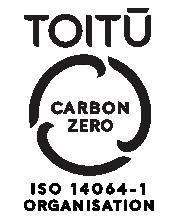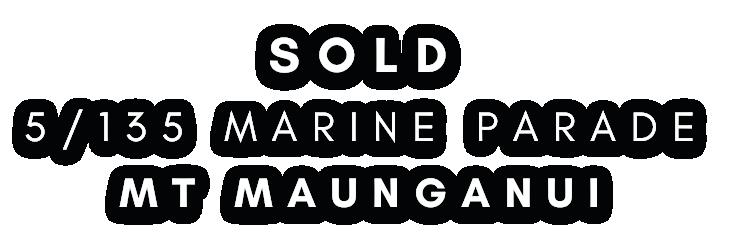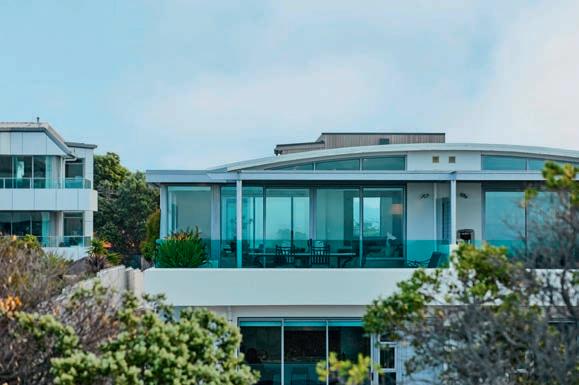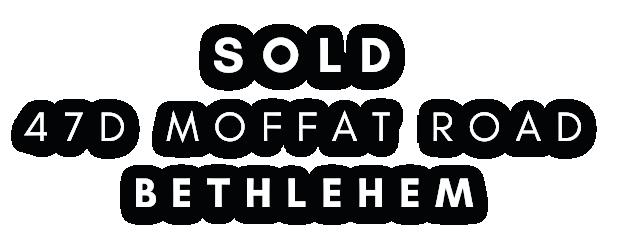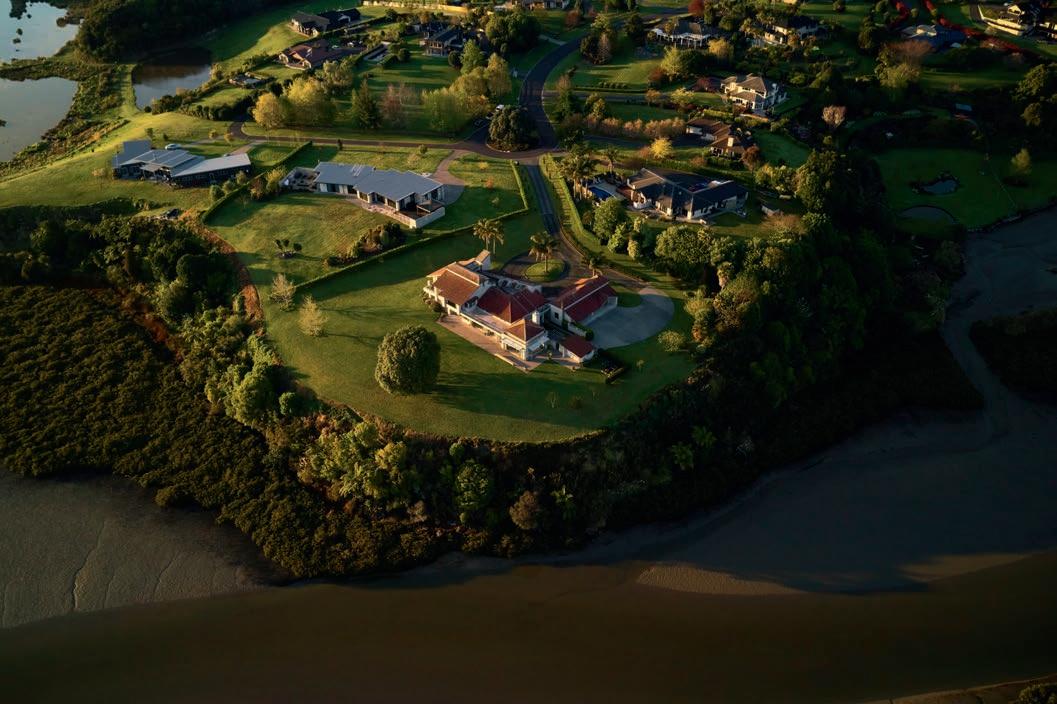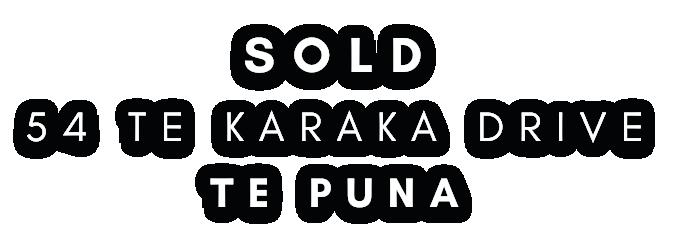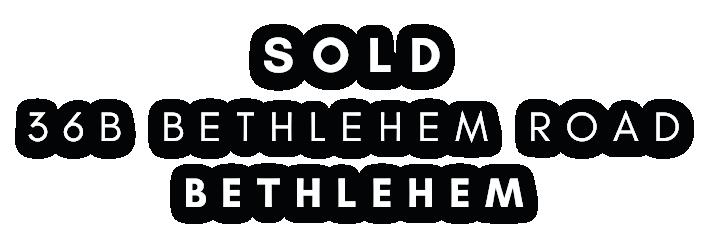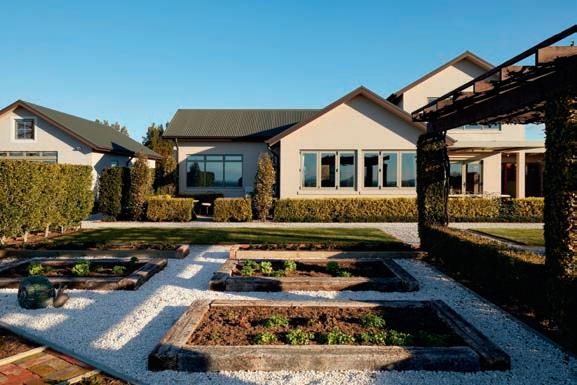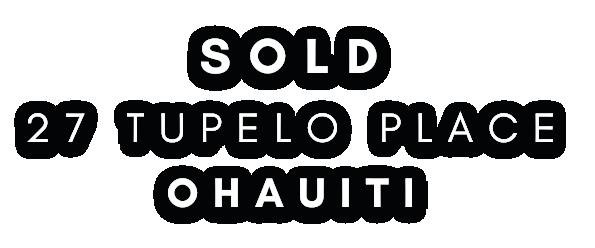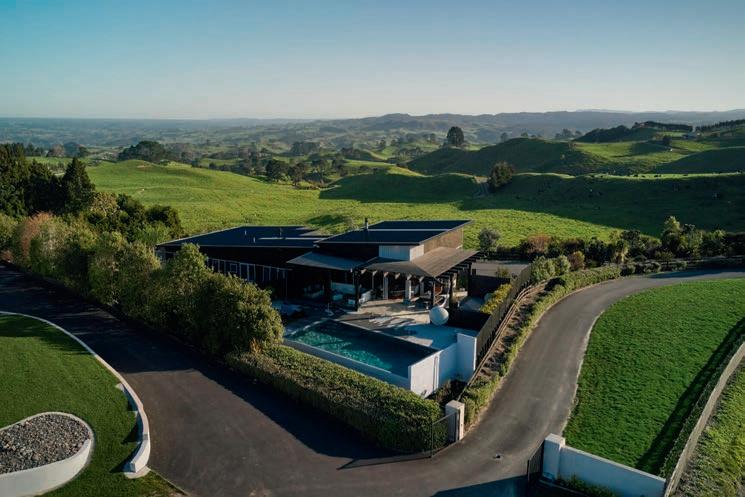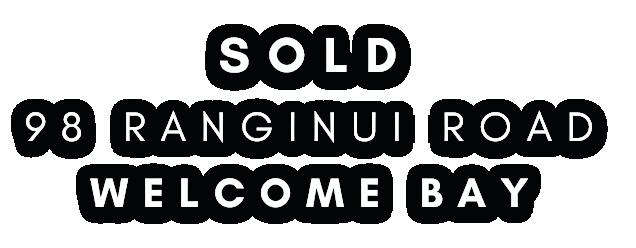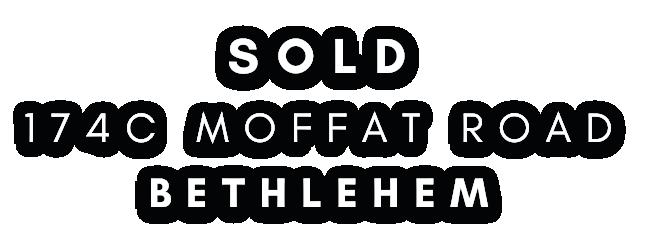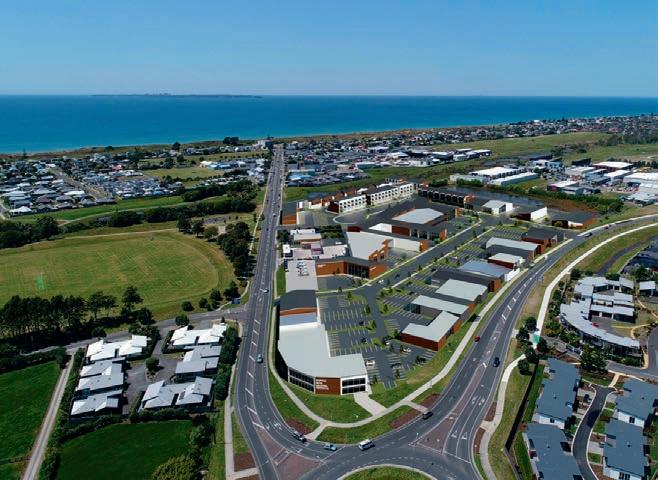
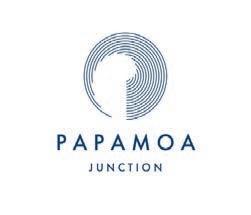
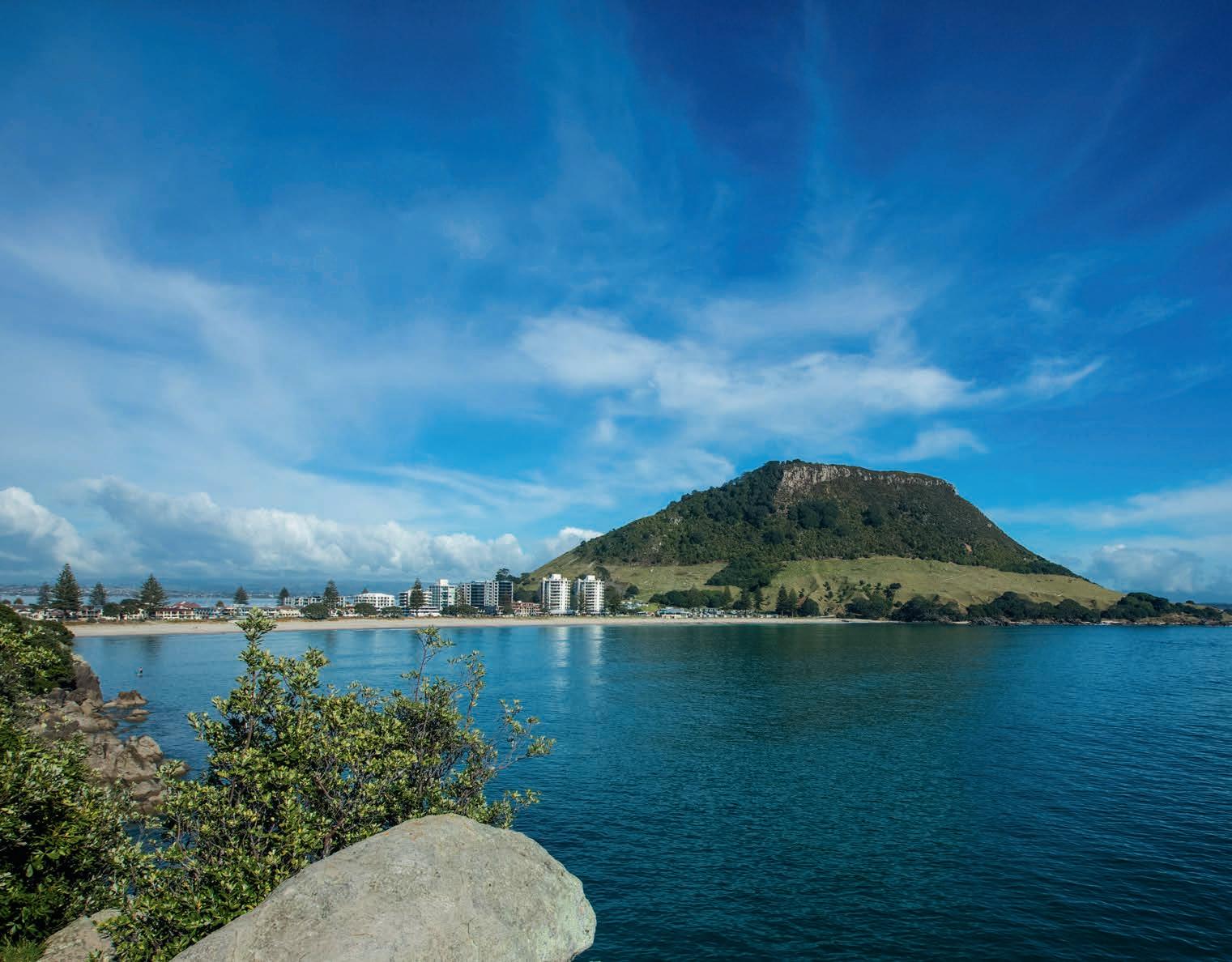
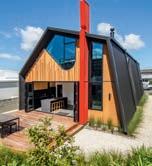
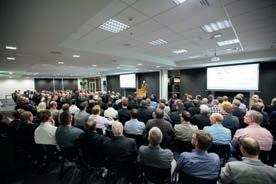












































































Rotorua Adventure Park Velocity Valley has decided to go ahead and launch its latest adrenaline-pumping ride in December, said sales and marketing manager Debbie Guptill.
By DAVID PORTER
Given the challenges of 2020, introducing a new ride was not something Velocity Valley had expected to do this year, said Guptill.
However, the support Velocity Valley had received from domestic travellers meant the time was right to introduce the new ride before summer, she said.
“Thankfully, with 70 percent of our normal patronage being domestic visitors, we have managed to buck the trend and mostly keep at that same level of customers following the lockdowns,” said Guptill.
Velocity Valley (formerly Agroventures Adventure Park) offers a number of adventure rides suitable for all ages and comfort levels.
Launched in December the new ride, V-Force reverse bungy, was set to push visitors’ limits, she said.
“The V-Force will see people launched 45 m straight into the air attached to bungy cords at speeds of up to 80km per
The V-Force will see people launched 45 m straight into the air attached to bungy cords at speeds of up to 80km per hour.”
– Debbie Guptill
hour,” said Guptill. “V-Force offers our customers even more selection when it comes to choosing rides at the park – whether they’re after something mild or wild on terra firma or above it,” she said.
In addition to the V-Force, the park’s Freefall Xtreme has also been upgraded with a giant 4.8m high transparent indoor cylinder, providing flyers with both an indoor and outdoor flying experience.

but without the parachute or jumping out of a perfectly good plane.
Debbie says the latest ride and the upgrade are perfectly timed for their summer holiday season, which they are expecting will be busy.




Velocity Valley is one of many Bay of Plenty operators that we plan to cover in the coming year who have segued into providing new products for the domestic market.





www.bopbusinessnews.co.nz
PUBLISHER
Alan Neben
Ph: (07) 838 1333 Mob: 021 733 536
Email: alan@bopbusinessnews.co.nz
EDITOR
David Porter
Mob: 021 884 858
Email: david@bopbusinessnews.co.nz
PRODUCTION
Copy/Proofs/Graphic Design
Times Media – Clare McGillivray
Ph: (09) 271 8067
Email: clare@times.co.nz
BUSINESS DIRECTOR
Pete Wales
Mob: 022 495 9248
Email: pete@bopbusinessnews.co.nz
EDITORIAL:
News releases/Photos/Letters: david@bopbusinessnews.co.nz
GENERAL INQUIRIES: info@bopbusinessnews.co.nz
Bay of Plenty Business News has a circulation of 8000, distributed throughout Bay of Plenty between Waihi and Opotiki including Rotorua and Taupo, and to a subscription base. www.bopbusinessnews.co.nz
Bay of Plenty Business Publications 309/424 Maunganui Road, Mount Maunganui, 3116
Bay of Plenty Business Publications specialises in business publishing, advertising, design and print media services.
I have been obsessed by the surreal saga of Donald Trump’s ongoing meltdown as he attempts to shut out the reality that he will soon be prised from the White House. In doing so, he will lose his presidential immunity from some – but not all – potential threats for criminal prosecution.
As we went to print to meet our pre-Christmas production deadlines –and despite the US Electoral College having firmly come down in favour of Joe Biden as the president-elect – Trump was continuing to rant into the early hours on Twitter and to push unfounded claims of fraud.
That was despite having lost some 50 law suits alleging electoral irregularities, with even Republican judges throwing them out of court. Admittedly, Trump’s legal team has been most notable for its bumbling incompetence.
However, despite Biden’s convincing win, Trump nonetheless managed to persuade more than 70 million voters to support him, suggesting that the divisions in US society ran even more deeply than had been suspected. His recent actions – including the failed appeal by his supporters for the Supreme Court to overturn the election results – have been essentially an attempted coup, and have exposed the fascistic tendencies of Trump and many of his supporters.
As astutely observed decades ago by the historian Eric Hobsbawm, in his The Age of Extremes (1994), reflecting on the rise of fascism in the 1930s: “Fascism could not formally believe in modernity and progress, but it had no difficulty in combining a lunatic set of beliefs with technological modernity in practical matters… It also provided the proof that men can, without difficulty, combine crackbrained beliefs about the world with a confident mastery of contemporary high technology.”
And of course, since then, the rise of the internet and the social media giants has only increased the ability of high technology to proliferate the dissemination of crackbrained beliefs – from QAnon’s nonsensical ravings that Satan-worshipping paedophiles are running a global child sex-trafficking ring, to David Icke’s bonkers theory that “higher beings” are on

Earth masking their true reptilian form in order to enslave humans.
Here in the Bay, we have had our own – rather less conspiratorial, but still troubling – political meltdown. The government has announced it will bring in, at the least a Crown Manager, and possibly appoint Commissioners to help the elected Tauranga City Council. The aim is to get the council back on track following its recent public displays of
lem: a final decision on Commissioner/Manager options will have to be approved by cabinet, which was not due to resume until well after Christmas.
Although as we went to print, at least two people had put their hands up to contest the by-elections, there seems to be little incentive for them to waste their money in doing so. If commissioners are appointed, the current councillors are all essentially out of a job – although they have the option to stay on in an unpaid basis.
In mid-December, the councillors issued their public reply to Minister of Local Government Nanaia Mahuta. The letter – a response to the minister’s request that they come up with a reason for her not to bring in commissioners – was essentially a plea for her to instead appoint a crown manager and observer. Which, of course, could also be seen as their acceptance of the reality of intervention, coupled with a hopeful plea to keep them on the payroll.
“We would like the opportunity to improve governance in a sustainable way, one that
Tauranga is a fast-growing city and investments in core infrastructure and core services need to be made to sustain the quality of life that our people should expect and deserve. We can’t expect to ‘get more for nothing’.” – Simon Clarke, Priority One
rancour and inability to work together. It was unclear when we went to print, which option would be taken.
The TCC has already begun the by-election process to replace both a resigned councillor and ex-mayor Tenby Powell. Our understanding is that timing has been a prob-
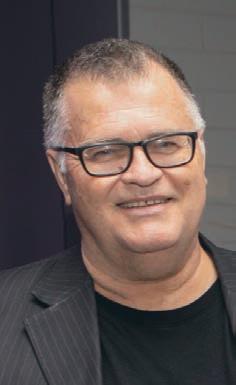
David Porter
participation can be set to one side for a moment, given voter turnout was around 40 percent in the last election. But in other similar cases, the commissioners selected seem to have been of high calibre, and to have taken their role very seriously, particularly with regard to engagement with the community.
There would seem to be a sound argument for bringing in the commissioners, having them fulfil their mandate, and produce a clear set of expectations for the next elected council.
New Priority One chairman Simon Clarke, a governance expert, told Bay of Plenty Business News that the economic development agency would be providing as much support to the Tauranga City Council as it could, as it goes through whatever intervention is required.
“Priority One’s view is that an intervention is needed to facilitate better decision-making and to grapple and deal with the infrastructure deficit challenges that TCC faces,” he said.
Priority One was expecting a commissioner(s) rather than a crown manager would be appointed, but would have to wait and see, he said.
“Continuing to do nothing [in order to] ‘keep rates down’ is not an option,” Clarke said.
preserves civic and democratic participation,” the councillors said, noting their position was supported by all elected councillors except for John Robson. In turn, Robson said he would not comment on his own position until after the minister had announced her decision.
The issue of democratic
“Tauranga is a fast- growing city and investments in core infrastructure and core services need to be made to sustain the quality of life that our people should expect and deserve. We can’t expect to ‘get more for nothing.’ My view is that I think rates will need to go up and alternative funding arrangements will need to be explored.
“However, it will be important that TCC is transparent so that we as ratepayers understand where the money is going and what improved outcomes we will be getting.”


By DAVID PORTER
Given the unprecedented year the Bay business community has been through and the problems that are still affecting us globally as a result of the Covid-19 pandemic, it is too early to make a call on the economic outlook for 2021.
Despite New Zealand’s strong exports, and generally improving business confidence, issues such as shipping logistics and construction log jams may well prove problematic in the next few months. But it does seem that the country has managed to come out of the first year of Covid19 and the initial lockdowns rather better than might have been the case.
Nigel Tutt, chief executive of Priority One, commenting just before the Western Bay
economic development agency’s annual general meeting, noted that the economy had bounced back well from the lockdowns, with indicators pointing towards at this stage towards a sharp “V” shaped recession.
“Unemployment has moved up, but so far not to the levels that would cause distress in the community,” he said.
“We’d expect it may drift up a little in early 2021 as the disruption to some sectors causes a shift in employment.”
But the outlook for 2021 remained uncertain, said Tutt.
“While things have been going well in the last few months, we should be wary of a depressed global economy, supply chain disruption and the prospect – albeit diminishing – of further lockdowns pre-vaccine.”
While things have been going well in the last few months, we should be wary of a depressed global economy, supply chain disruption and the prospect – albeit diminishing – of further lockdowns prevaccine.” – Nigel Tutt
Simon Clarke, who took over the chairmanship of
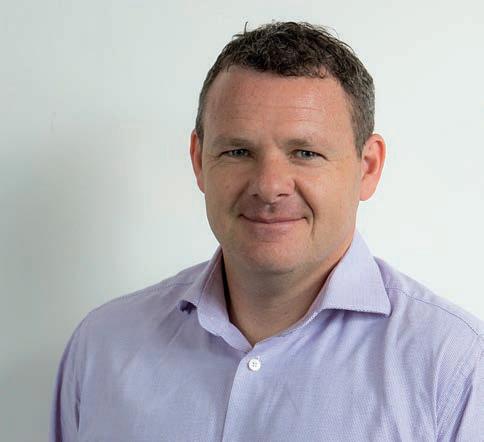
Hewlett – who resigned the position after five years – said he remained cautiously optimistic that the Western Bay economy would continue its
strong bounce back in 2021.
“However, pre-Covid-19 issues around housing unaffordability, environmental degradation, infrastructure
deficiencies and increasing social inequality in our community, have not gone away,” said Clarke.
“If anything, those issues have been magnified and laid bare for all to see throughout 2020.
In 2021, we need to focus on accelerating our recovery by ensuring that we continue to grow intelligently and sustainably, and we need to focus on improving outcomes socially, environment and culturally. Not just economically – we want quality growth.”
An eventful year
In their general comments on the year in the AGM report, Tutt and outgoing chair Hewlett, noted that 2019/20 year had been one of the more eventful in Priority One’s history.
Turn to page 6
The December AGM saw chairman Brett Hewlett, who has served for five years, resign and his role taken by former deputy chair Simon Clarke. Nigel Tutt described Hewlett as a man of great mana. “His great business acumen is matched by a desire to provide better outcomes for this community, and to ensure sustainability well into the future,” he said.
Clarke – who has served for eight years with the Priority One board – spent several years in senior positions with Trustpower before recently resigning to set up Matua Governance. He told Bay of Plenty Business News he was excited about taking over the mantle from Hewlett, who had done a great job.
“I believe that relative to some other regions, Tauranga Moana is extremely well-placed to flourish and prosper in a post-Covid-19 world,” said Clarke.
“2021 is ‘our moment’ to accelerate our efforts,” he said. “I’m looking forward to continuing to help the P1 team support and develop our important relationships with central government, the BOP Regional Council, the Tauranga City and the
Western Bay councils and our broad business membership. I’ll be putting my shoulder and energy behind the fantastic team that we’ve got to get stuff done.”


Do you have a plan on how to best meet your future financial needs? Ensuring that you have enough income to see you through retirement and are able to manage unforeseen changes in income can be a significant challenge. At Forsyth Barr we have a dedicated team who can help you to plan, build and manage an investment portfolio to suit your needs.
Whether you need to maintain a certain level of income, or grow funds to help future generations reach their financial goals without the burden of debt, we can provide the expert help. Contact us for a free review of your investments in confidence and a no-obligation discussion on how we can help you achieve your future financial goals.
40 Selwyn Street, Tauranga. (07) 578 2737 forsythbarr.co.nz
From page 10
“During this period we have moved from an economy that was growing at a swift pace, with low unemployment, to seeing the extremely disruptive effects of the Covid-19 pandemic and lockdown, with businesses in distress, then finally moving onto the path of a strong recovery.”
The Priority One leaders said they were pleased to report that economic activity, measured through retail spend and heavy vehicle movements, had returned to normal levels, and unemployment increases that have been modest.
“In many cases New Zealand has positively outperformed the dim expectations of late March/April. We see the Western BOP as performing a couple of percentage points ahead of the country.”
The Western Bay would come out of the pandemic in good shape for a number of reasons, they said, noting:
• Our strong growth coming into the downturn was able to carry us through, many businesses came back from lockdown with strong pipelines and customers.
• Our export sector, led by kiwifruit, honey and manufacturers, has fared well in global markets.
• We have a diversified economy for regional New Zealand, with relatively low exposure to international tourism and travel.
• Strong population growth has continued, fuelling
some of this economic growth. We expect to remain an attractive destination in the future, highlighting the need to plan accordingly.
But despite the local economy coming through the pandemic well, it did not mask some of the challenges ahead.
While the Western Bay’s growth has traditionally been strong, they said:
• Our incomes are lower than
that we were already seeing (with younger and lower skilled jobs more susceptible) and wealth inequality, with rising house and rental prices.
“In addition to this we must do more to ensure that our economy is more environmentally and socially sustainable in the future,” said Tutt and Hewlett.
“Our strategy to accelerate economic development in the
Pre-Covid-19 issues around housing unaffordability, environmental degradation, infrastructure deficiencies and increasing social inequality in our community, have not gone away.”
– Simon Clarke
the New Zealand average and many other cities.
• Our rapid population growth has outstripped infrastructure and land availability.
• Our housing market is in crisis, with the worst housing and rental affordability of any major New Zealand city.
We have Māori employment outcomes that are generally worse than the rest of the population.
• The pandemic had accelerated the income inequality
Western
these points alongside taking the opportunities in front of us.”
Strategy for growth
Tutt and Hewlett – who worked closely with incoming chair Clarke on the strategy for the coming year – said it had a joint value and growth approach.
“Firstly we must accelerate our developing regional innovation ecosystem so that we can build more value into our
Akey issue for all local business in 2021 will be payroll costs. Remuneration specialists Strategic Pay recently released their November Remuneration and Business briefing, highlighting expectations and concerns of employers across the country.
Cathy Hendry, senior consultant for Strategic Pay in Tauranga, said for its latest survey, 230 responding organisations were asked to forecast the
overall payroll increase anticipated for the year to September 2021.
The overall average rise in payroll anticipated by the respondents was 1.9 percent, with 10 percent of organisations reporting that they still didn’t know what increases would look like due to the pandemic.
“General staff are being forecast to get the higher of the increases, in line with commentary we have seen come through from our pulse surveys, where
General staff are being forecast to get the higher of the increases, in line with commentary we have seen come through from our pulse surveys, where organisations were mainly wanting to focus on their legal commitments, for example with living wage or minimum wage movements, and then not much else.”
– Cathy Hendry
organisations were mainly wanting to focus on their legal commitments, for example with living wage or minimum wage movements, and then not much else,” said Hendry.
“As we move up the staff levels, we see smaller increases, until we get to just over one percent forecast for CEOs and senior executives. Whether this will actually flow through into the salary increases provided going forward –we shall see.”


economy, create higher value employment and take advantage of international opportunities,” they said.
“We have a cluster of innovative businesses that has potential to grow. We must harness the opportunity in our Māori community, with a growing and youthful workforce, land holdings and momentum.
“At the same time, we must take a step change in how we grow as a region, growth must take place in a more intelligent way, to do this we need to change the equation for better results.”
Priority One believes this will require greater partnership between business and government (local, regional and central) to provide the region with the planning and resources to keep growing in a sustainable manner.
“Having a strong economic strategy in partnership with government is a key enabling factor.”
The number of jobs in small businesses across New Zealand grew 1.4 percent during October and were now above pre-crisis levels, according to global small business platform Xero.
The company released its Xero Small Business Insights (XSBI) in the last quarter of 2020, as we went to print.
That followed the strong recovery from the initial downturn experienced in April due to the initial nationwide lockdown.
Small business revenue remained relatively flat, decreasing by 0.4 percent during the period, compared to the previous year.
But Xero’s managing director for New Zealand & Pacific Islands, Craig Hudson, said the summer break offered Kiwis the opportunity to dig in and support their local businesses.
“Now’s the time for Kiwis to make a commitment to buying local and supporting the small business economy in their communities,” he said.
Support local hospitality
“This is especially true of our hospitality industry, which
needs our continued support after three consecutive months of negative year-onyear revenue growth.
“For those who can, get in some domestic tourism, eat at local restaurants and choose local products when buying gifts. This will help the nation’s economic recovery immensely, and help the country end the year on a high note.”
Hudson said it was encouraging to see employment figures growing, which remained in line with traditional seasonal trends.
“With the exception of hospitality, jobs in all industries across the country have recovered to, at or above pre-crisis levels,” he said.
“The manufacturing and retail industries in particular have seen good recovery during the month.
“Looking at the hospitality sector, we saw jobs fall early in the crisis and they have remained pretty flat since then, despite revenues improving.”
Hudson said a restricted labour supply due to border restrictions, coupled with fears of new lockdowns, meant small business owners were working longer hours
Now’s the time for Kiwis to make a commitment to buying local and supporting the small business economy in their communities.”
– Craig Hudson
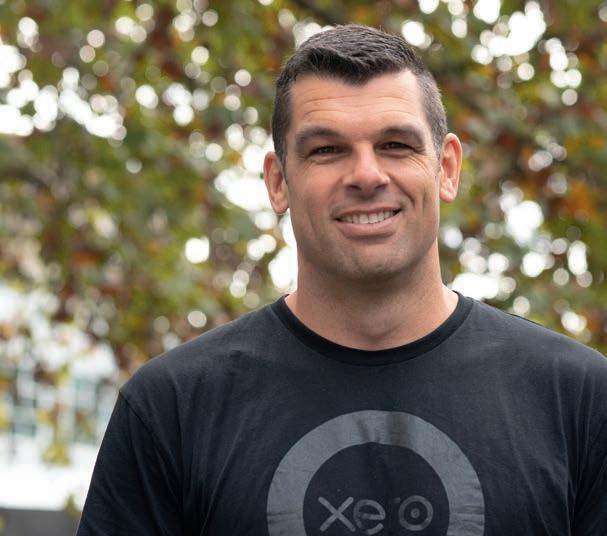
without hiring new staff.
But he hoped to see that change, especially moving through Christmas and the summer break.
Positive growth indications
Compared to pre-crisis levels, there was positive growth in job figures in Canterbury (6.7
percent), Hawke’s Bay (5.4 percent)), Wellington (5.2 percent), Bay of Plenty (4.7 percent) and Northland (3.3 percent) as at the end of October.
However, Auckland (-2.9 percent) and Queenstown (-5.0 percent) were yet to completely recover the jobs lost during the initial COVID19 lockdown.
Outside of Otago (-4.3 percent) and Waikato (-5.1 percent), small business revenues were up year-on-year in October in Northland (8.5 percent), Bay of Plenty (3.8 percent), Auckland (1.2 percent), Canterbury (0.5 percent) and Hawke’s Bay (0.4 percent), according to Xero data.

After three months or so of global equity markets generally bouncing sideways, they surged in November fuelled by two key events: (1) markets’ view of a benign outcome in the US election, and (2) substantial positive progress on Covid-19 vaccines.
Equity markets were led higher by more economically exposed companies and sectors whose earnings are more sensitive to underlying economic conditions and therefore the re-opening of economies.
As such, markets with more of these cyclical companies, such as Australia (+8%) and Europe (+6%), outpaced those comprising more defensive companies including New Zealand (+6%) and the United States (+3%), particularly through November.
Those more defensive sectors and markets remain strongly ahead year-to-date.
Also reflecting the greater confidence in the economic outlook and investors’ increased appetite for owning risk assets:
Bond prices fell, with yields rising off historic lows, as the price being paid for safety reduced.
• The NZD rose, appreciating
+4% against the US dollar and +5% against the Australian dollar over the quarter, offsetting some of the performance from international assets for unhedged domestic investors.
President Trump, you’re fired!
The first key event in November was the US election. In the highest turnout since 1900, the results did end up being closer than betting-odds and many polls predicted. As expected, the Democrats retained control of the House of Representatives, but, against predictions, the Republicans look likely to have held the majority in the Senate (albeit we won’t know for sure until January). The Democrats have likely fallen short of securing a “Blue Wave”, sweeping the Presidency, Senate and House of Representatives, which would have provided a platform for significant policy reform.
This split Congress should limit Joe Biden’s policy agenda (for the next two years at least) including reducing the likelihood of market unfriendly tax policies and greater regulation on the likes of the tech and healthcare industries. It
also means government fiscal stimulus is likely to be lower, requiring more of the support for the economy to come from the US Federal Reserve, including keeping interest rates low.
The US election was closely followed by the biggest news of the quarter, highly promising trial results from three Covid19 vaccine candidates. All three showed strong efficacy in trials – BioNTech/Pfizer and Moderna both around 95%, and Oxford/AstraZeneca up to 90% (albeit further testing is being undertaken).
All far exceeded the US Food and Drug Administration (FDA) approval hurdle of at least 50%.
Other vaccines are also at the final testing stage. Time to develop vaccines is often measured in decades. It looks like we’ll have multiple Covid-19 vaccines available in less than a year. Anthony Fauci, head of the US National Institutes of Health, called the results “just extraordinary”.
The next step for these vaccines is regulatory approval, which is particular to each country.
> BY BRETT BELL-BOOTH
Investment Adviser with Forsyth Barr Limited in Tauranga, and an Authorised Financial Adviser. Phone (07) 577 5725 or email brett.bell-booth@forsythbarr.co.nz.
To speed up the process, emergency-use authorisations are available in some countries allowing higher-risk portions of the population to be vaccinated early. We’ll likely see a ramp-up of vaccine production and distribution through 2021 supporting slow, but steady progress toward more normal economic conditions.
We believe the backdrop remains a positive one for investing in risk assets such as shares and property. Real interest rates (after inflation) are generally negative. Central banks commitment to ultralow interest rates is forcing investors to look for alternatives outside of traditional safe havens such as term deposits and bonds. The lack of any significant inflation means this position does not look likely to be reconsidered any time soon. Global economic activity has exhibited a V-shaped recovery in areas such as housing sales, construction, retail sales, and manufacturing. Many companies in New Zealand and offshore are experiencing better-than-expected
outcomes, which is translating through to better employment demand. Investors should be confident that, in general, the trough in company earnings is behind us.
The recovery could face a setback over the next few months as the latest wave of the pandemic sweeps back through the Northern Hemisphere. However, the recent success around vaccines means markets are largely looking “over the hill” to a world where medical preventions are being rolled-out.
2020 has been an extraordinary year for the world and for markets. Back in January, very few predicted that within months we’d experience the first global pandemic in over a century, in a couple of months most of us would be working from home, and we’d see the fastest bear market (a 20% decline in equity prices) in history. Equally, as equity markets were plunging in March, few predicted we’d be back hitting record highs less than six months later. It really has been a roller-coaster ride. The good news to end the
year is, that on combating the virus, we look to be on a positive path.
Given the recovery in equity market values since March, we note that:
1. markets are able to remain resilient in the face of bad news, 2. share prices reflect the longterm earnings companies will generate over the years and decades ahead, not just the next six to 12 months, and 3. it’s not possible to consistently time or predict shortterm movements in markets. Overall, it’s important to establish and remain committed to an investment plan which meets your long-term goals. After such a challenging year we extend our best wishes to you and your loved ones for the holiday season.
This column is general in nature and is not personalised investment advice. This column has been prepared in good faith based on information obtained from sources believed to be reliable and accurate. Disclosure Statements for Forsyth Barr Authorised Financial Advisers are available on request and free of charge.
As the repercussions of the global pandemic continue to shake down in the New Zealand economy, it is becoming clearer that the industrial sector has largely been shielded from many of the body blows that other sectors have experienced – and continue to endure.
Now that the sting in Covid-19’s tail has caught up with us, it is hoped that the industrial sector continues to thrive. The wheels of activity in the industrial arena have kept turning, with certain sub-sectors outpacing others and barely missing a beat, while other innovative businesses have jumped quickly to meet new demands.
Supermarkets were the winners during the strictest lockdown times and as demand ramped up for home delivered groceries, so too did the supermarket operators’ search for dedicated “dark store” premises to handle the unprecedented online orders.
Exports resilient
Exports within the primary sector – notably dairy, meat and horticulture – have been resilient despite global economic volatility. According to a report by the New Zealand Institute of Economic Research, this country’s agricultural export revenue for the almost-five months from 1 February to 24 June – was up nearly $1 billion on the same period last year.
This kept processing plants, packhouses and supply chain
partners active and although the wind was knocked out of forestry, seafood and manufacturing, export sales, ports around the country report optimism and increasing volumes as the world gets to grips with an altered reality.
Keeping goods moving and services “open for business” has been paramount to ensuring that the country’s economic recovery across the board is given a fighting chance.
Many businesses that occupy industrial space have reassessed their capability and physical footprint needs – some retrenching space and others expanding – and Bayleys has been involved with numerous lease restructuring and subleasing transactions to facilitate this.
The mantra being touted by the country’s leaders and echoed by the business community is to “support local” as we try to emerge from the Covid-19 scenario in a sound fiscal position.
The manufacturing sector is hopeful that New Zealanders will support locally made products and the clothing industry is one that may be regenerated on the back of this new wave of patriotism. With global supply chains
still fragmented, perhaps Kiwi ingenuity will really come to the fore and we’ll see an invigorated manufacturing industry – one that helps with domestic employment fundamentals at the same time as bringing out local pride.
Just how “think and buy local” will translate into demand within the industrial property market is yet to be fully seen. But there’s plenty of activity in the sector right now – both in a traditional usage context and in the hunt for premises to cater for new niche businesses.
Bayleys’ research shows vacancy levels are sub-1.5 percent across prime and secondary industrial stock in the Auckland region and there’s similar patterns being observed in other main centres.
Rents appear stable for now, and incentives – while still being offered on a case-bycase basis in some instances –have also stabilised.
E-commerce was already flying high pre-pandemic but with restrictions on physical movements during New Zealand’s staged series of lockdown measures, Kiwis got click-happy and demanded a lot from those businesses with online capability and expected

Supermarkets were the winners during the strictest lockdown times.
those without a credible online platform to adapt and get with the programme.
Logistics and last-mile delivery operators have been under the pump since March as they moved from delivering essential goods only, to fulfilling orders placed in a fullblown spending frenzy once restrictions eased.
Courier companies have been searching for extra warehousing capacity, NZ Post has leased additional space to deal with rising parcel volumes,
and retailers have been on the hunt for overflow storage space to satisfy growing online demand for goods.
NZX-listed Goodman Property Trust recently announced via its online AGM: “50 to 60 cents of each dollar going into property wants to go into industrial,” which is in-line with a global chase for logistics and industrial land, buildings, tenants and development sites.
As we brace ourselves for the repercussions of a poten-
tial second wave of Covid-19 in New Zealand and face the reality of a W-shaped recovery, we’re hopeful that the industrial property sector will remain resilient, adaptable and viable for landlords and tenant businesses alike.
Remember, Bayleys’ industrial leasing team is here to help and we’re always available at the end of the phone or email to talk about the market, opportunities and solutions. For more property insights, see www.bayleys.co.nz/workplace

What an interesting 2020 we have had world-wide. I’m sure we all appreciate looking forward to 2021 and Trustpower Baypark is no exception.
Bay Dreams will be kicking off in 2021 with a pre-party on 2 January and the main event on 3 January. International travel restrictions aside, there will be 30 acts to entertain and start 2021 off with a bang. These include a few of the biggest international DNB & hip hop artists that could be convinced to quarantine (with government approval), plus lots of local kiwi talent.
Speedway
Do you have the need for speed? Speedway Season has started already and there are many more meets over summer with action-packed fun for the whole family. Upcoming summer dates are January 5, 8, 9, 16, 29 & 30, February 6 & 20, March 6, 13 & 27.
To enjoy watching the races in style, we have a number of exclusive, spacious Corporate Boxes with balconies, available to entertain up to 20 guests comfortably.
They have full kitchen facilities, including microwave, table, chairs and bar stools. A self-contained refrigerator for ongoing inbox bar service with dedicated corporate box catering stewards for continuous supply along with a high-quality catering service delivered to your box.
These boxes are also available on an annual basis to cover the entire Speedway Season. Please contact us on events@ bayvenues.co.nz or 07 577 8593 for more information.
Bring some colour to your summer and register for the Farmer Auto Village Colour Dash on January 24. The Farmer Auto Village Colour Dash is a 5km non-competitive fun run or walk for people of all ages where participants are splashed with a hurricane of special colourful dust at each kilometre. Every registrant gets: a free t-shirt, a bag of colour and an explosion of fun.
Macky Gee
Macky Gee will be performing on January 31. Smashing through the barriers of the conventional and carving a
path for himself, Macky has turned the heads of some of the industry’s biggest players to become one of the most promising and spectacular artists in Drum & Bass music today.

From weekly radio shows to playing gigs around the UK and Europe, Macky wanted to carry on building on this creative vibe and soon found himself going to college to study Music Production learning his craft and honing his studio skills to give him both the desired confidence and knowledge to push forward making his own original tracks. which would eventually change the sound of drum and bass.
The Seniors and Travel Annual Expo is on again on February 27 & 28 – 10am to 3pm at Baypark. There will be caravans on show for tripping around, and lots more options to suit all tastes and budgets. The organiser explains: “The purpose of the Expo is to provide seniors with firsthand opportunities to discuss products and services usually advertised in magazines and newspapers alone.”
The Expo will showcase a vast range of services and products for seniors in one convenient location – and it’s all for free. An event not to be missed, with loads of information and entertainment, and tastings for all.
Bill Bailey is back
Following a thumbs-up from immigration, Bill Bailey makes Aotearoa his first touring destination in the Covid-19 era, announcing a 12-centre 2021 tour of New Zealand, landing in Tauranga on 25 March.
How did we get here? How do we find our way through this? And exactly who are we again?
In Bill’s new show, En Route to Normal, Bill ponders these and other questions that this moment in history has thrown up and tries to see a way through the strange unreality of our new world.
With Bill naming the show before we’d even heard of Covid-19, En Route to Normal is not just a funny, heart-warm-
FarmerAutoVillage
ing mix of stories, music and history, but a personal mission to find our way through these strange times.
Tracing lines through chaotic moments in history, Bill seeks out parallels where human resilience and our ability to endure has got us through times of strife.
Through music, songs, and memories, Bill considers our changing priorities, the wonder of dogs, how little things can keep you on track, and rhapsodises on his new-found love of skydiving.
He recounts his own experiences of dealing with isolation, ruminating the ‘sounds of lockdown’ which led to a greater appreciation of birdsong and perhaps led to the creation of music itself, and how our reliance on technology has inspired Bill himself to create dance remixes of video-calling ringtones.
Last in Aotearoa in 2018, the British Comedy Award winner is a frequent visitor to our shores, with Kiwis flocking to theatres to see the master in action. Irreverent and immensely talented, En Route To Normal will be the seventh show that Bill has brought down under, delivered with the energy the multi-faceted entertainer is known for.
With his trademark blend of satire and surrealism, stories and dismantled jokes, crowd sing-alongs, weird instruments and musical showstoppers, don’t miss this legendary comedian, musician and actor back on stage in New Zealand in 2021.
Premier conference venue
Trustpower Baypark is Tauranga’s Premier Venue for conferences, meetings, entertainment and exhibitions. Offering a complete package in one convenient location that features state of the art meeting rooms, in-house catering, audio visual services, professional conference organiser (PCO) and marketing/promotional services.



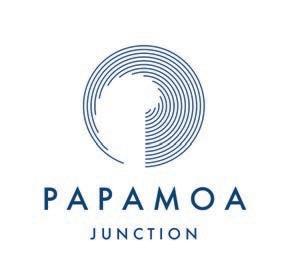
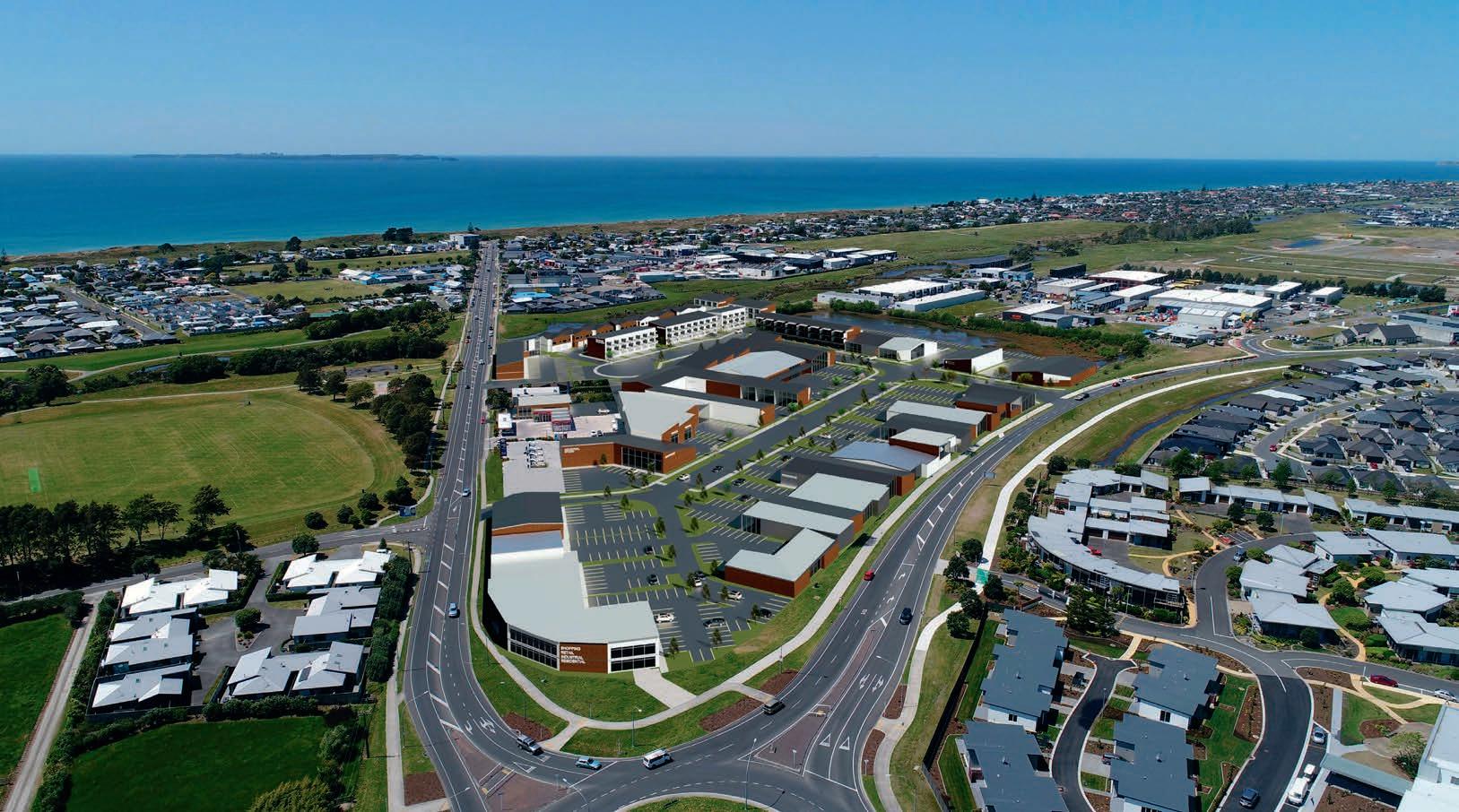
Carrus – one of the country’s biggest land developers – is now underway with development of its mixed residential/light commercial subdivision: Papamoa Junction.
By DAVID PORTER
Carrus is fresh from completing its successful development at The Lakes in Tauriko, and is also engaged in other major developments around the North Island, namely in Wellington and Taupo.
Nearer to home base it is developing the Nga Roto Estate in Five Mile Bay, in a prime location of Taupo, which will become a modern residential development and where sales were “going berserk”, said Scott Adams, Carrus Managing Director.
Adams is also Managing Director of all of the company’s residential land developments and commercial development companies. He noted that with The Lakes now finished, there was a strong desire to push ahead with Papamoa Junction, which has been owned by a Carrusmanaged entity for the last 11 years.
“The problem with Tauranga is that it’s very difficult to secure developable land,” said Adams. “It’s either unavailable or if it is available, it’s unaffordable,” he said.
“Every block that we’ve looked at [locally] in recent times is constrained in some way, whether it’s because of restricted access, poor zoning, covenants that prevent further subdivision, or natural hazards like flooding and liquefaction, or simply the cost of the land.
“If it wasn’t difficult enough for developers to have all those things going against us, there’s also the RMA [Resource Management Act], which has morphed into a bipolar piece of legislation that is long overdue a serious reform.
“Is it an environmental act or is it an urban development act? Time has shown that it cannot successfully be both. If Tauranga has any chance to grow and thrive then the current gov-
Turn to page 12
The problem with Tauranga is that it’s very difficult to secure developable land – it’s either unavailable or if it is available, it’s unaffordable.” – Scott Adams
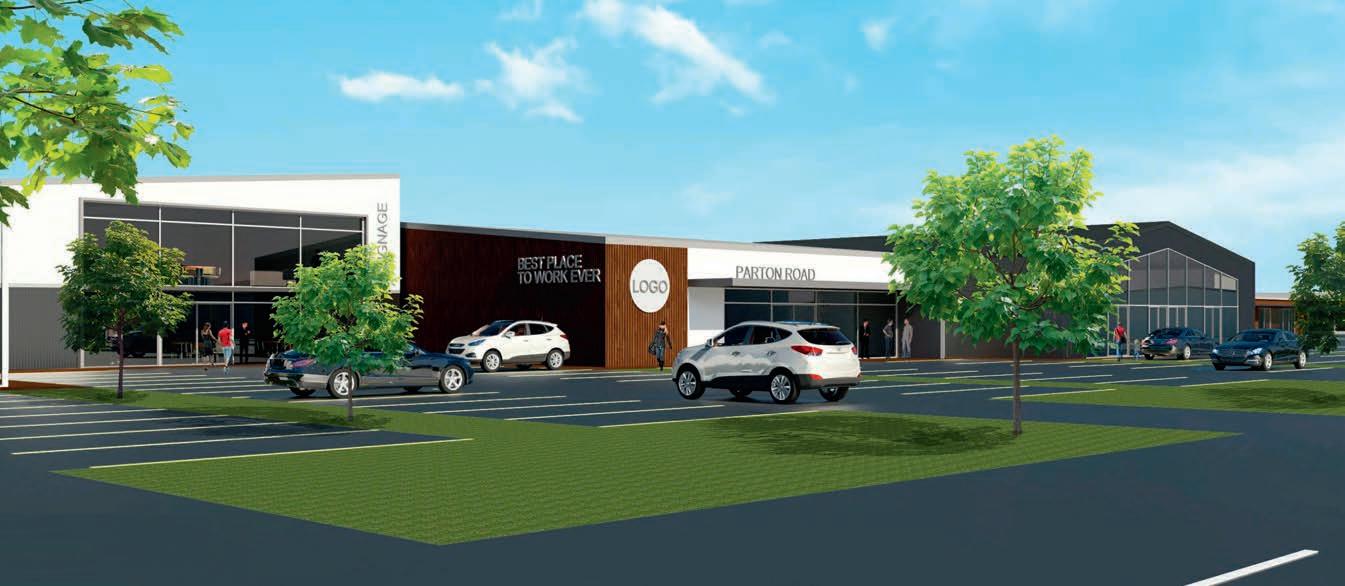






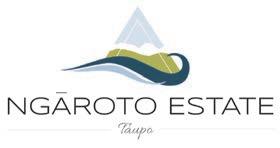

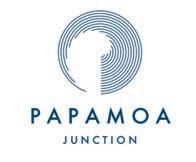

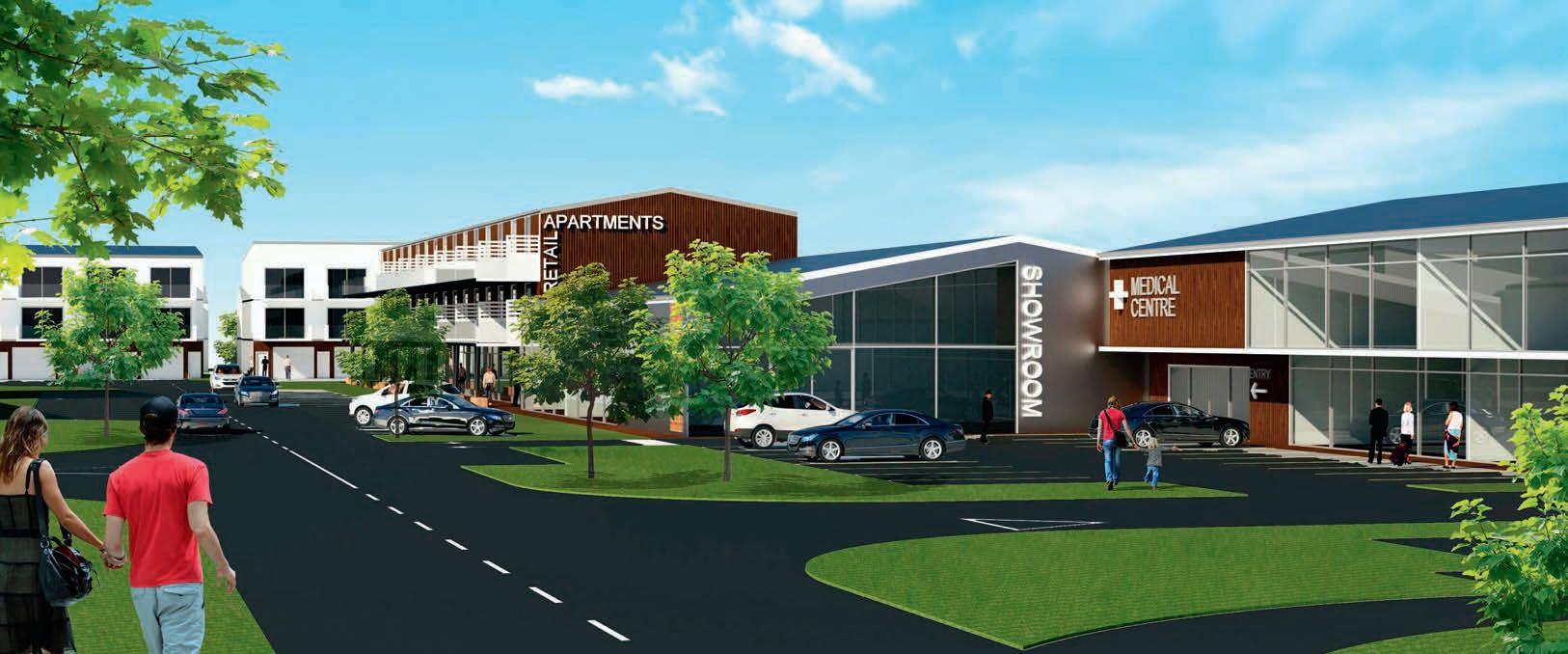
ernment needs to simplify or remove the RMA and replace it with fast-track legislation.”
Councils and landowners have considered options for urban development at Papamoa East’s Te Tumu for years and that potential 760ha site is now part of the SmartGrowth strategy. But even in a best-case scenario, it would be at least three years before any development would occur at Te Tumu, said Adams.
“Everyone knows that Tauranga has a major problem with housing supply – the city needs an additional 40,000 houses over the next 30 years in the city just to keep up with the population growth. Where is this going to come from?”
Future Urban growth areas Te Tumu and Tauriko West are still several years away from starting. Adams said that every Tauranga citizen had to get in behind both these plan changes when they finally get notified in 2021, because these areas will help ease housing demand and smooth increasing house prices.
Leading companies involved
Carrus said it had assembled a great team to undertake the Papamoa Junction development. It involves a number of leading property sector companies, including JMC contractors, engineering firm Aurecon and real estate giant Colliers International.
As designed, Papamoa Junction comprises 41 mixed-use commercial lots and two residential super lots with Barrett Homes underway with designs for approximately 60-70 two and three-storeyed townhouses ranging from 145sm to 160sm adjacent to the Wairakei Stream reserve. Residents will have a straight line walk to the Papamoa Beach, said Barrett Homes’ Mike Bryant, who is co-owner of the company with Grant Eynon.
“There is lots of residential development in the area, and schools just up the road and an amazing local community,” said Bryant. “We
Turn to page 14
“There is lots of residential development in the area, and schools just up the road and an amazing local community. We think it’s going to be a development that is definitely in demand in that area.” – Mike Bryant

SECTIONS AVAILABLE FOR SALE WITH ASKING PRICE + GST (if any) 230 PARTON ROAD, PAPAMOA
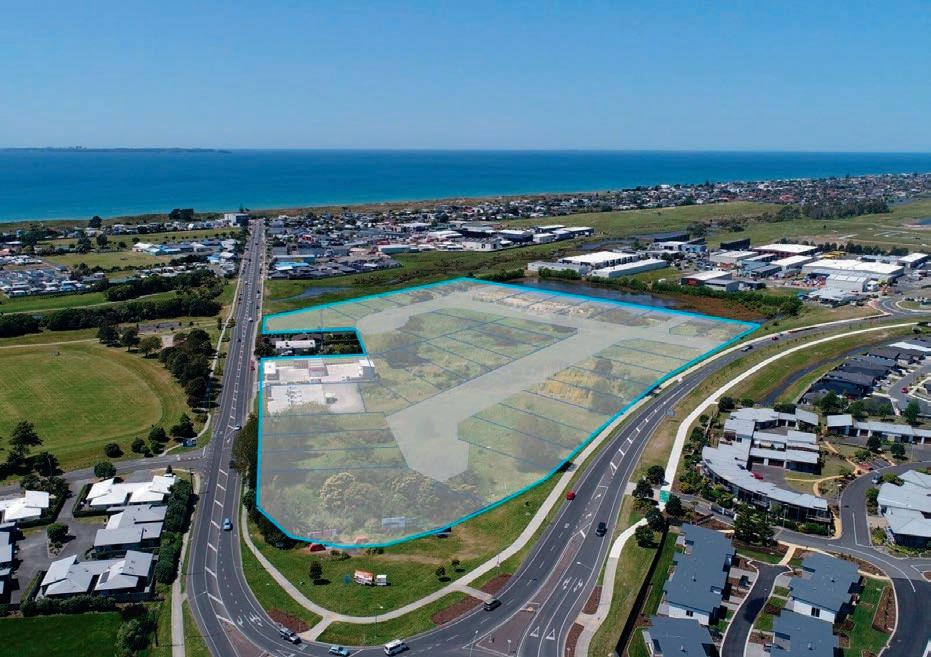
Papamoa Junction is a significant development site in the heart of Papamoa East´s commercial hub.
Papamoa Junction is a significant development in the heart of Papamoa East´s commercial
With
SECTIONS AVAILABLE FOR SALE WITH ASKING PRICE + GST (if any) 230 PARTON ROAD, PAPAMOA
Papamoa Junction is a significant development site in the heart of Papamoa East´s commercial hub. With
Papamoa Junction is a significant development site in the heart of Papamoa East´s commercial hub.
With
5.25 hectares of buildable land for sale in 43 individual freehold titles, this offering represents an exceptional opportunity for those looking to own a piece of Tauranga´s fastest growing area. Sites range between 864m² and 2,530m² in size and range from $750/m² for internal sites, to $800/m² for sites with road frontage.
With 5.25 hectares of buildable land for sale in 43 individual freehold titles, this offering represents an exceptional opportunity for those looking to own a piece of Tauranga´s fastest growing area. Sites range between 864m² and 2,530m² in size and range from $750/m² for internal sites, to $800/m² for sites with road frontage.
5.25 hectares of buildable land for sale in 43 individual freehold titles, this offering represents an exceptional opportunity for those looking to own a piece of Tauranga´s fastest growing area. Sites range between 864m² and 2,530m² in size and range from $750/m² for internal sites, to $800/m² for sites with road frontage.
5.25 hectares of buildable land for sale in individual freehold titles, this offering represents exceptional opportunity for those looking piece of Tauranga´s fastest growing area. between 864m² and 2,530m² in size and range $750/m² for internal sites, to $800/m² for road frontage.
The versatile commercial zoning allows for residential, retail, office and light industrial uses. Initial demand has been significant with well over 80% of the sites with purchasers to date. Ensure you register your interest with Simon or Rich to avoid disappointment.







The versatile commercial zoning allows for residential, retail, office and light industrial uses. Initial demand has been significant with well over 80% of the sites with purchasers to date. Ensure you register your interest with Simon or Rich to avoid disappointment.

The versatile commercial zoning allows for residential, retail, office and light industrial uses. Initial demand has been significant with well over 80% of the sites with purchasers to date. Ensure you register your interest with Simon or Rich to avoid disappointment. Simon
The versatile commercial zoning allows for residential, retail, office and light industrial Initial demand has been significant with well 80% of the sites with purchasers to date. register your interest with Simon or Rich disappointment.
Simon Clark – 021 959 710
Simon Clark
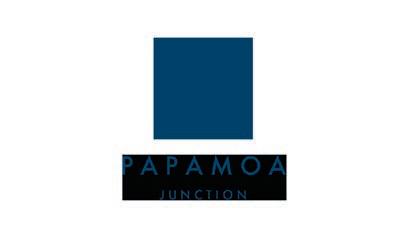
Rich Davidson – 027 860 9338













SHAPING THE FUTURE
SHAPING THE FUTURE
BULK EARTHWORKS ROADING DRAINAGE
LAND DEVELOPMENT SURVEYING
TRANSPORT
BULK EARTHWORKS ROADING DRAINAGE
LAND DEVELOPMENT
SURVEYING TRANSPORT

JMC are proud to be associated with The Lakes
JMC are proud to be associated with Papamoa Junction


















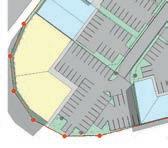






COLLIER CONSULTANTS CONGRATULATE
SCOTT ADAMS AND THE CARRUS TEAM ON PAPAMOA JUNCTION




We are proud to be associated with the project, providing a full range of Planning and Resource Management services for Papamoa Junction.
CCL are passionate about ensuring best practice outcomes. Our significant experience enables us to provide accurate and efficient expert planning advice to a wide range of public and private sector clients. We also work with the best professionals in the industry to pull together a tailored team for projects.
www.collierconsultants.co.nz
From page 12
think it’s going to be a development that is definitely in demand in that area.”

Bryant said the overall “feel” of the development would be “timeless” and the homes would have a quality look in keeping with the surrounding area.
Barrett will also be building a small commercial development with some retail lots and office space, possibly with some form of hospitality operation to anchor it, he said.

Earthworks underway
Scott Adams says earthworks are underway and should have been completed by Christmas with civil works commencing in New Year 2021, with titles in October.

“People can expect a high level of amenity with a Carrus subdivision,” he said. “Papamoa Junction will be no exception with a high calibre of development standards, landscaping, walking and cycle connections.”
Greg Watters, Chief Operating Officer for JMC Civil Construction, said Papamoa was generally sandy country. The good side of that was that it was nice material to do earth works with, he said, but when the Spring winds get up, it posed a risk from an environmental aspect.

“That’s the real challenge, the wind,” he said.
The contract has been awarded as two parts: for the initial earth works, which JMC aimed to finish before Christmas, and then the civil engineering works.
“There is a fair bit of interest from the local community because people have been seeing it sit here for a long time and wondering what will happen here,” said Watters.“It’s deemed to be a fairly high-profile project.”
Karl Mischewski is the Sustainability Manager of Gull Group, which has had a station on the site for several years. “We were the first cab off the rank several years ago and built when it was an orchard,” he said.
“I guess we were the first to see the potential to go ahead in Parton Road way back when. At that time we looked at the future growth strategies for Papamoa and came to the conclusion that it could eventually become the Bay of Plenty’s third-largest city.”
Gull leased the site off Carrus originally, and now they were dividing and selling it, Gull would be looking to acquire the site, said Mischewski. “We had the confidence to go ahead when there were just a few shops down at the beach,” he said.
“I recall us taking out the trees to develop the site, which was surrounded by paddocks. We can certainly see what’s happened since then. The Parton Road development is
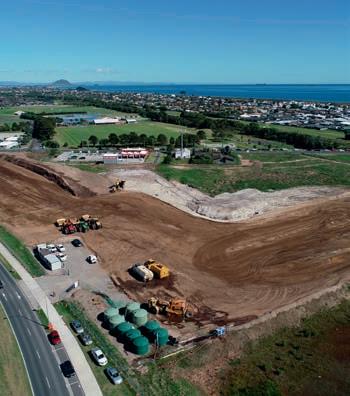
Aurecon provides specialist consultancy services for infrastructure and urban development projects. For Papamoa Junction, the firm has provided the stormwater and civil design, cadastral survey, specialist geotechnical, contaminated land and traffic engineering services.
Aurecon’s Technical Director Land Infrastructure, Neill Raynor, said these factors were all key to successful, larger residential and commercial developments.
The residential/light commercial mix in Papamoa Junction was becoming more common, and is accommodated in the Tauranga City Council’s rules, said Trainor.
“But some of the key challenges are making sure the residential space is nice to live in,” he said.
“The lots along the Wairakei Stream corridor are a good location for outlook and green space within a commercial zoned area.”
Raynor said the location of Papamoa Junction was important as the catchment was growing with the residential growth in Wairakei, with traffic back into the traditional commercial centres around Bayfair and beyond getting busier.
“The block is handily adjacent to some main roads so access to and from the development is good,” he said.
“Creating safer intersections with allowance for pedestrians and cyclists in particular has been important, with the existing shared path already across the frontage, and the close proximity of schools, sports fields, etc.”








For three decades, Registered Master Builders House of the Year competition has recognised the very best homes, builders, and craftsmen across New Zealand. This year marks 30 years of the competition.


n a first for the competition, this year the awards were announced virtually.
Builders across the country gathered with colleagues, friends and families to watch from the comfort of their own homes, workplaces, or at local viewing parties hosted at Master Builders regional branches. Triple Star Management Lim-



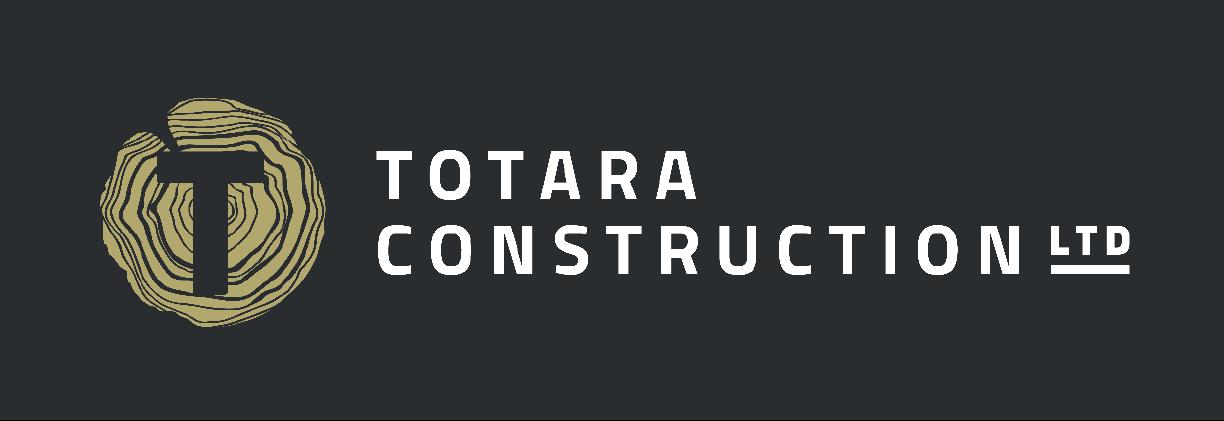
ited, based in Queenstown, took home the Supreme House of the Year for their Southern House.
Taupo house takes Supreme Renovation of the Year
Taupo based Haimes Building won Renovation of the Year. They also walked away with the Bunnings Renovation Over $1 Million award. Judges said this renovation, that was two years in the making, was an impressive example of collaboration between the passionate homeowners, a clever designer, and a craftsman builder.
tain the old, and create a seamless result.
“Renovations always present challenges, require great planning, and need lot of thinking along the way to incorporate the new, main-
“From the hinuera stone personally laid at the entry, to the endless straightening of the original structure to cope with the unforgiving new light from the atrium windows on the gib board, the workmanship has been executed beautifully.
“This is a wonderful alteration




Totara Construction is a true custom home building company specialising in
and
With an eye for
and an unwavering commitment to
craftsmanship coupled with seamless
management. The result is an extremely well
Totara Construction is partnered with Grace Saathof Interiors to ensure timeless style and that your personality is reflected throughout your home.



Registered Master Builders
Chief
“Each
“Our
“But











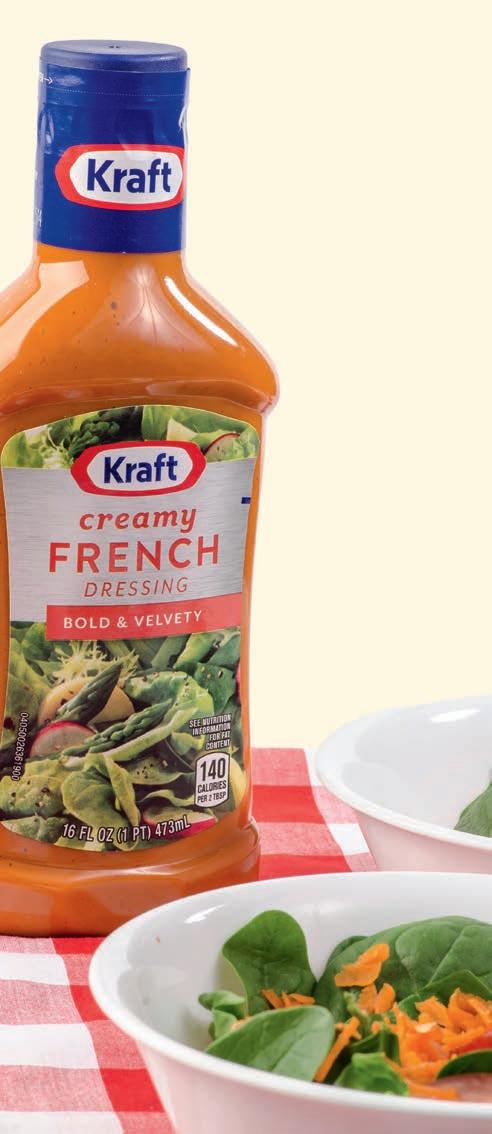
The outcome of the Kraft Foods Group Brands LLC and Bega Cheese Limited case in Australia could have an impact on legal approaches to trade mark registration in New Zealand.
Trade mark rights are assigned – transferred – from one owner to another all the time. How many trade mark owners know, though, that if they assign an unregistered trade mark to another owner, then not only do they have to assign the goodwill in that trade mark, they also, as a matter of law, have to assign the underlying goodwill in their business, too? If they don’t, the assignment is likely to be invalid.

> BY BEN CAIN
Ben Cain is a Senior Associate at James & Wells and a Resolution Institute-accredited mediator. He can be contacted at 07 928 4470 (Tauranga), 07 957 5660 (Hamilton), and benc@jaws.co.nz.
his issue was at the heart of litigation over the ditch between Kraft Foods Group Brands LLC and Bega Cheese Limited, which was recently brought to a conclusion by Australia’s highest court.* The High Court of Australia denied Kraft Foods the opportunity to appeal the decision of the Full Federal Court of Australia, which upheld the above legal principle. Although an Aussie decision, it is likely to be followed in New Zealand. What’s the logic? Well, according to the Federal Court, unregistered trade marks are not recognised under Australian common law as “a species of property” – unlike registered trade marks, which are. What is recognised, and therefore protected under Australian law, is the goodwill or rep-
As we relax into summer, not only is it the season of family gettogethers and beach barbeques, it is traditionally also the period where many consider their future, how they avoid going back to work in their old jobs in the New Year and what sort of business they should buy.

> BY NATHAN BONNEY
Nathan Bonney is a director of Iridium Partners. He can be reached at nathan@iridium.net.nz or 0275-393-022
s the end of 2020 approaches and we enter 2021, I suspect there will be a few more people thinking seriously around whether a franchised business is the option for them.
In previous articles I have discussed the various approaches in regard to due diligence, most recently suggesting that a potential franchisee entrepreneur should start with a motivational analysis, i.e. asking themselves “why” they are looking at buying a franchised business.
My assertion is this is going to assist in guiding a potential purchaser as to what types of businesses they should be looking at. But once they have done this, what are the other
“soft” non-financial or legal due diligence items?
When we are guiding potential franchisee entrepreneurs there are three key areas we suggest they consider.
The work-life balance
After all, the elusive work-life balance is the reason that many purchase their own franchised business. In many cases, it’s true, you could go for a surf during the day or watch the kids play sport, but the reality is it’s going to be your business, and ultimately there is no work-life balance, balancing work being really a part of your life.
The questions then are, how much time do you want
to spend in the business versus on the business, can you manage a business where you may get phone calls at any time any day, or do you need a business where you can compartmentalise your time? Are you required to be in the business every day, and for how long?
From my experience, perhaps the number one issue that franchise business owners become dissatisfied with or more importantly, are not successful at, results from them misunderstanding, or misestimating the amount of time and effort required in running a business.
Family involvement
The motivation for many in
utation in an unregistered trade mark that has been generated by the use of that unregistered trade mark.
According to the Federal Court, however, the goodwill in an unregistered trade mark “is inseparable from the business to which it adds value”; consequently, the goodwill in an unregistered trade mark “cannot be dealt with except in conjunction with the sale of that business”. In other words, you cannot sell/transfer the goodwill in your unregistered trade mark without also selling/transferring the underlying goodwill in your business – the goodwill in the unregistered trade mark and the business cannot be divided. That can change things dramatically, especially the purchase price of the trade mark.
How does that work though
if your company carries on several discrete businesses under different unregistered trade marks? Where a company carries on several discrete businesses (as in the Kraft Foods case), the principle will apply to each separate business, such that an unregistered trade mark may be assigned together with the goodwill of the related business, rather than the company’s business as a whole
Why it is problematic
On a practical level, assigning the underlying goodwill in a business together with the goodwill in an unregistered trade mark is in most instances unlikely to be an issue, as the whole of the business is being sold anyway.
The issue becomes problematic when the seller wants
How much time do you want to spend in the business versus on the business, can you manage a business where you may get phone calls at any time any day, or do you need a business where you can compartmentalise your time?
to carry on the same business (for example, manufacturing and selling peanut butter) after market has sold its unregistered trade mark for that business.
According to the Federal Court, the seller will do so without any goodwill in its business – i.e. the only assets the seller may have are its plant, equipment, property and staff. All the goodwill the seller had in its business must be re-built from scratch.
The goods news is you can prevent the issue from arising – by registering your trade mark. Under the Trade Marks Act 2002, the owner of a registered trade mark has the exclusive right to assign or transfer a registered trade mark either in connection with the goodwill of a business or not.
You can therefore assign your registered trade mark to a purchaser without losing the underlying goodwill in the business generated by your use of that trade mark. Registering your trade mark is a no brainer then, really.
* Kraft Foods Group Brands LLC v Bega Cheese Limited [2020] FCAFC 65

purchasing a franchise business is to spend more time with the family in a family business.
It may come as a surprise that, according to the Franchise Relationship Institute, this motivation is actually inversely related to statistical business success rates.
The due diligence questions here are: have you worked with your spouse or family before, and how will you structure the business?
What will the respective roles be for each family member, how much time and attention will they be required to spend in the business.
And of course, what are the expectations from each
family member in terms of remuneration?
People involved with the brand
The cliché is that being in a franchise business is being in business for yourself but not by yourself. This is reassuring. But a franchisee entrepreneur needs to take into consideration the other parties that are associated with the “not by yourself” part of the business. These include not only the primary franchisor and the key franchise support team members, but also other franchisees. All of these people will
have varying levels of contact with the franchisee entrepreneur and impact on their relationship with the brand. This impact can extend to other franchisees and how they manage their own business and represent the brand. The due diligence process here is to speak to as many people associated with the brand as you can. Do so at the brand or head office level, and also at a franchisee and perhaps former franchisee level. Can you work with these people, are they competent, are they doing a good job by the brand that you are looking at investing in? Can you see yourself doing what they are doing?
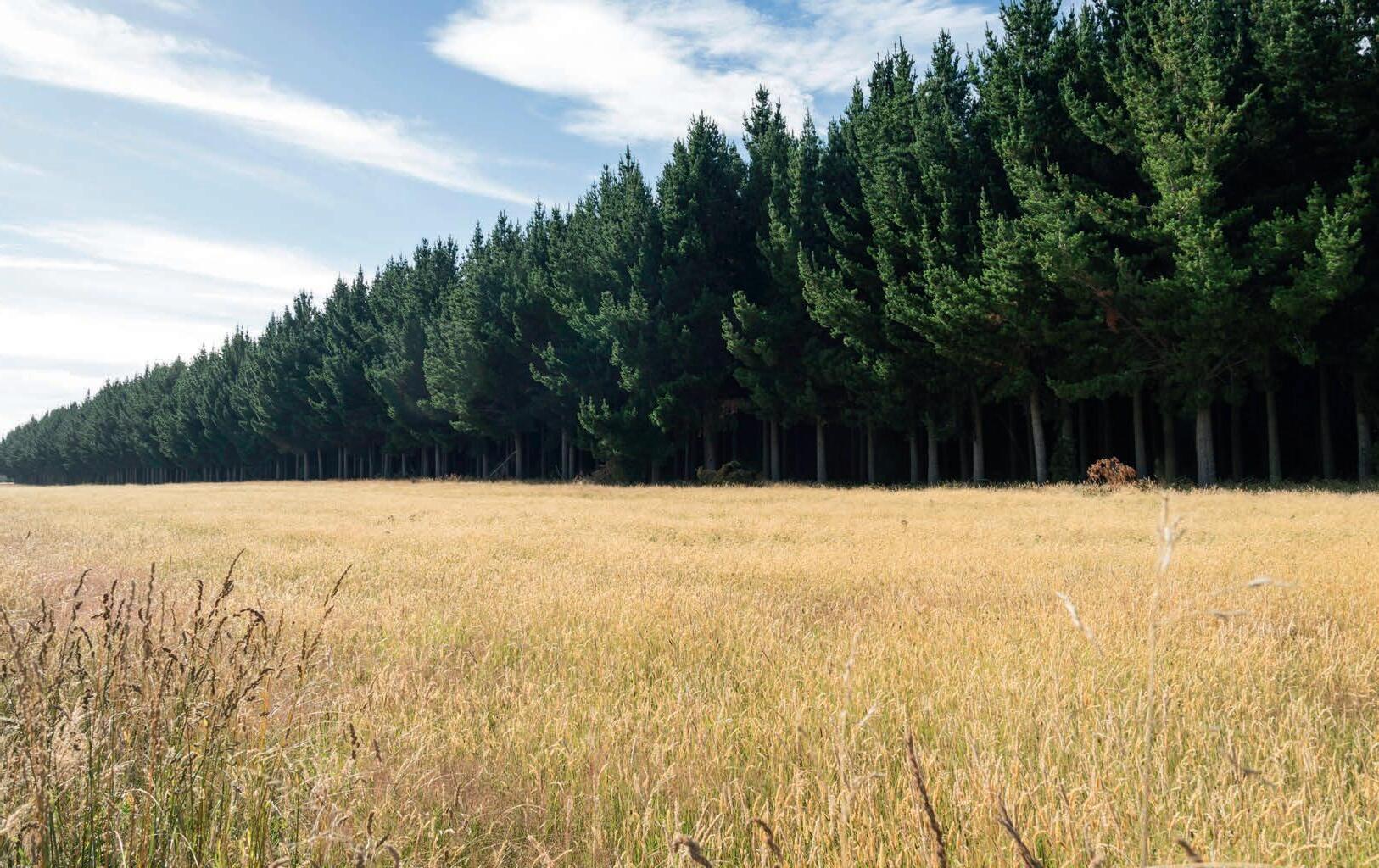
Forest owners have responded with dismay to government plans to double down on intentions to limit the areas that can be planted in exotic production forests.
By RICHARD RENNIE
Prior to the election, a growing surge in opposition to pastoral land being turned into forestry resulted in Minister for Agriculture Damien O’Connor undertaking to make resource consent a requirement for planting of forests over a certain area.
He has since confirmed a resource consent would be required on forest plantings on land over 50ha that falls into the higher quality land use classification (LUC) of 1-5.
In Bay of Plenty, 25 percent of the region’s land is categorised as LUC 1-5. The remaining three-quarters of the region’s land falls into categories LUC 5-8, becoming progressively poorer in quality.
Given the first three land classes 1-3 were too expensive to be planting trees on, the main LUCs affected by the consent proposal in Bay of Plenty are LUC 4 and 5.
Greater impact in the Bay
The change in consent would have a relatively greater impact upon plantings in Bay of Plenty, which has almost half its forestry planted on LUC 4 and 5 land, and would require a consent if on farm-
land and was to be expanded over 50ha.
This contrasts with the national average where about 75 percent of the country’s forestry estate is on LUC 6 or 7.
Western BoP, Whakatane and Rotorua collectively account for one-third of the 560,000ha of forest area recorded in the Central North Island, by far the country’s largest exotic forest growing region.
Pressure has risen on government to review the rate of forestation, despite its “1 billion trees policy” as rural groups raise concerns in regions like Wairarapa and Hawke’s Bay over land conversions to forestry.
Farm Forestry Association Graham West of Rotorua said the move to curtail property rights was a concerning one.
“We have run a few field days on farm forestry in Bay of Plenty, and the owners are happy with how they have combined forestry into their operations.”
He pointed to the Mossop family, who were combining manuka honey production with pine plantations, as one example.
Forest Owners Association president Phil Taylor said enabling regional councils to require resource consents for tree plantations only made for-
I am concerned government continues to buy into a belief that farming should have priority over forestry. The two activities are quite compatible.” – Phil Taylor

estation more complicated and costly.
“By and large, forestry is a permitted activity on all land other than highly erodible country.”
Planting activity can already be limited on grounds of fire risk, landscape impact and water quality issues.
Taylor pointed to some inadequacies in the government’s move to cap forestry.
“I am concerned government continues to buy into a belief that farming should have priority over forestry.
The two activities are quite compatible.”
There was also the issue of trying to control land-owners’ rights about what they can and cannot do on their property, despite claiming to be mindful of those rights.
Damien O’Connor said the policy was one for local government to enact, not an overall national policy.
While acknowledging the impact it may have on landowners’ rights, O’Connor said no one had “absolute” rights over land and the policy aimed
to protect productive land.
Values could be affected
But Taylor maintains forestry plantings can increase farm profits, particularly as landowners can now receive annualised payments from year 10 of their plantings for carbon value.
He also pointed to a relatively low point in total exotic forest plantings as an indication the country was a long way from being overplanted in trees.
Of 58,000ha of new forest plantings done in the past decade 40% was on improved farm land, but the rest came from unimproved pasture and scrub country. In contrast wholesale conversions from trees to dairying, including in Bay of Plenty and Waikato, totalled almost 40,000ha over the same period.
The total exotic forested area in New Zealand is also sitting near a 10-year average of 1.73 million ha, below the 2003 peak of 1.827 million ha reported in 2003.
There’s no shortage of great ideas in New Zealand. But for an innovative bunch, we’re not the best at realising the full potential of our innovations, particularly when exporting them.
At James & Wells, we can identify your competitive edge, offer business strategies for specific markets and help you own and leverage your intellectual property to ensure no one steals the fruit of your labour.
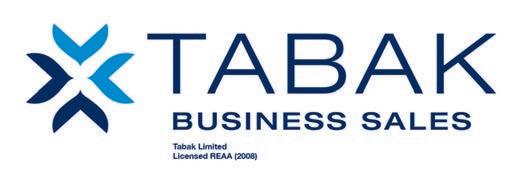
When is the right time to sell your business? Right now.
At TABAK, we promise to guide you through the sales process with focus, integrity and complete confidentiality.








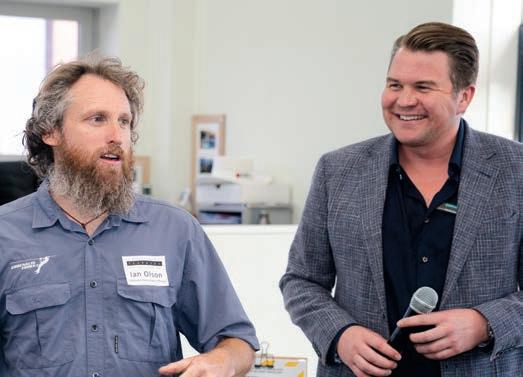
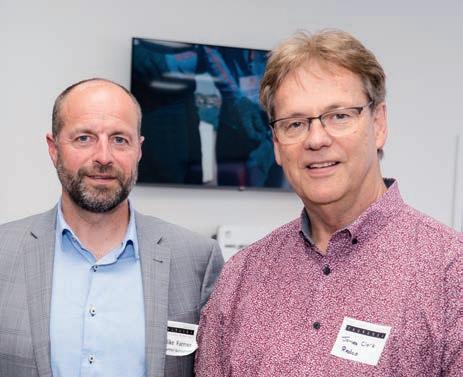

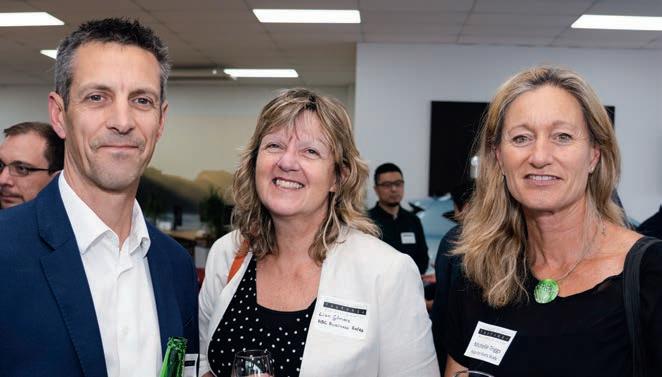

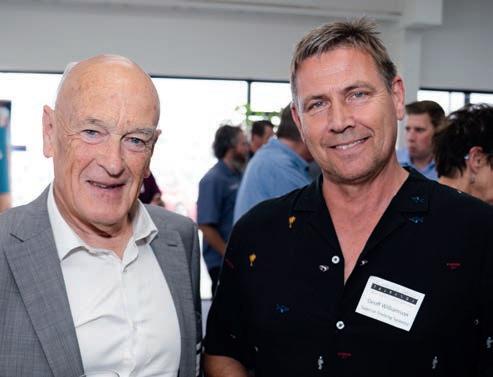
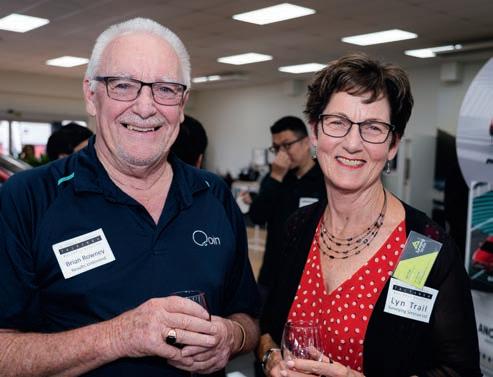
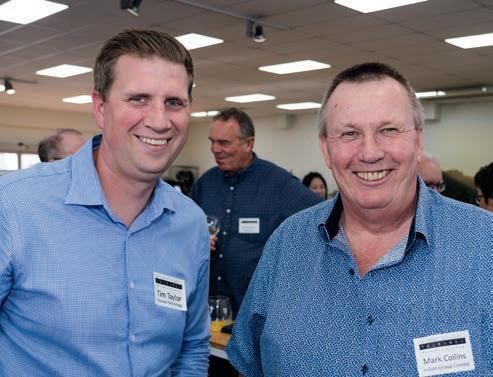

During 2020, new data and privacy laws came into play, remote working exploded, and cybersecurity, data protection and IT risks become constant conversation pieces. Business owners and operators had to become IT experts overnight. Nontrained IT staff in organisations have also had IT-related tasks added to their workload.
This may have not been a new thing, but demands seem to have increased and expectations and keeping up the knowledge can be daunting.
This period of the year has historically been the time for new jobs, and changes of roles and you may face a hole in the organisation with knowledge and the “go-to” IT person leaving for pastures new.
This is a great opportunity to review what resources are required and to get the best bang for your buck. So do you outsource or hire in house with specific IT assistance in mind, or look at a co-managed IT solution.
Deloitte’s latest Global Outsourcing Survey found that
57 percent of companies outsource so that they can better focus on their core business.
Benefits of IT service outsourcing
Focusing on your core business activities and outsourcing activities like IT has many potential benefits including:
• Helping create a business culture where everyone is focused on achieving the same goals.
• Increased in-house productivity: When employees do not have to worry about certain IT tasks that they have little to no experience with, they are free to focus solely on their day-to-day job duties and core business functions. This can result in increased employee productivity as well as reduced stress associated with having to perform IT tasks.
• It reduces the amount you spend on business functions that don’t directly contribute to revenue growth. Hiring and managing in-house employees requires a sig-

nificant time investment.
> BY TONY SNOW
Tony Snow is chief executive and co-founder of Stratus
He can be contacted at Tony@stratusblue.co.nz.
• It’s a cost-effective way to improve your team’s efficiency. Outsourcing enables you to have an in-house team that can leverage the support of outsourced workers. When having an outsourced IT department, you can often cut costs in relation to your company’s IT requirements and can provide more skilled resources for less money. Spend can be fixed and budgeted. For example, having an IT team in-house can be costly, whereas outsourcing your IT tasks can reduce costs in relation to salary, employee equipment, benefits and more.
• An Outsource IT depart-
By all accounts this past year has not been a typical one for anyone in NZ and that is certainly no different in the industries I work in. I thought I would take this opportunity to reflect back on the past 12 months and recount just one of our more memorable jobs (on the advice of our lawyer we have slightly changed some details to protect privacy).

> BY NICK KERR
Nick Kerr is Area Manager BOP for EC Credit Control NZ Ltd.
He is also a director of International Private Investigations Ltd. Nick can be reached at nick.kerr@eccreditcontrol.co.nz
n the investigations and repossession industry you don’t often get seen as the good guy by all parties in the situation. But over the past year we have partnered with a nationwide estate management company that gives us the chance to give good news to those who we come in contact with and please our clients just the same.
A few months ago we were contacted by an estate manager who had tried all avenues to locate the beneficiary of a large estate.
The estate manager knew the beneficiary’s gender and first name and that was it. No date of birth, no surname and no next-of-kin details. “We know we are asking you to do the impossible and have no
Over the past year we have partnered with a nationwide estate management company that gives us the chance to give good news to those who we come in contact with and please our clients just the same.”
expectations of you being able to do this,” the estate managers told us.
Our initial research was to do an analysis on the first name to see how common it was. In this case there were approximately 11,000 people worldwide with the same first name. The highest concentra-
tions of this name were Mexico, Hawaii, Samoa, Tonga and Niue, with some in New Zealand and Australia. We had some intel that the beneficiary travelled in and out on New Zealand frequently so working on that assumption we looked at countries which are New Zealand territories or had
ment remains upskilled, trained and has your best interests at heart. Most IT companies have expertise in several IT areas as well as special equipment or technology that allows them to be more productive and provide a higher level of services. Outsourcing IT tasks can often result in an increased quality of task completion compared to having in-house staff complete the tasks. Maintenance, security and updates get done and disaster recovery plans can be checked.
There are also reasons to hire in house
• An employee will have
greater buy-in to your company.
• Knowledge and skills developed by working on your projects is kept in-house and is available for later use.
• An employee has greater familiarity with your organisation, simply because they are onsite all the time and, depending on your IT company arrangements, you have greater cost control.
• It prevents doubling up of work efforts, which can happen in communication from your employees to a third party.
Data sensitivity and size of company. Are you comfortable an outside party may have operational control
over certain business functions and potential access to sensitive information?
Many IT services require that you provide sensitive information pertaining to your business’s security and data, so you should also get a clear idea of how the IT resource – either in house or externally – will protect your information.
A co-managed IT situation is also popular where an in-house champion looks after either strategy and longterm plans where an outsource IT department looks after the dayto-day operational aspects. Or vice versa.
With the right agreement in place with an outsource IT department, which deals with hundreds of different business environments, getting up to speed and having best practices can be implemented easily and effectively. I recommend that you weigh up over the break the pros and cons of outsourcing vs employing for specific requirements, and stay safe this summer.

a reciprocal agreement allowing for visa free travel starting with the Pacific Islands.
We got in touch with the community leaders in these countries and after a couple of weeks got the break we needed, made a few phone calls, verified the information then presented the estate manager with the beneficiary’s full legal name, address, email address, phone number and photo ID.
As you can imagine, they were very happy with the service as was the beneficiary, who had no idea any inheritance was due at all.
• 280 successful repossessions out of a total of 290 repossession orders received.
• Four major fraud/ commercial espionage cases investigated, and $4.5 million worth of loss prevented.
• 85 “unfindable” debtors located out of 88 requests received.
In a job where you mainly get sent out to confront people or discover nefarious activity, and you see people at their lowest ebb – whether in the grips of addiction, a downward cycle of depression or actively involved in criminal and harmful activities – it makes a really refreshing change to be an instrumental part of a real positive change in someone’s life. In addition to the above example, some numbers we’ve achieved in the last year have included:
• More than $2 million worth of liquidation loss avoided for 40 credit management clients. And that is in addition to my other work of setting up 100 best practice credit management systems for local businesses to prevent debt and liquidation losses. All in all, it has been a great year for business and I would like to thank all of our clients that have trusted us, the suppliers that we have had the pleasure to work with, and the readers that have read my ramblings and given me some wonderful feedback. Best wishes from me and my team for a profitable, rewarding – and above all enjoyable 2021.
Picking up new business takes time and investment. Yet many business owners make it their focus, sometimes at the expense of servicing their existing customer base.
As we head into 2021 and reflect on the year that has been, many of us will no doubt be thankful for the support of our long-term customers. For a lot of Bay of Plenty businesses, it’s repeat business that has got them through.
So why not make them your focus in the New Year? Not only is it the right thing to do, but you will often get a better return on investment when pitching to people who already know your products and the great service you provide.
Here are a few ideas to keep your customers engaged and to help ensure you stay at the forefront of their minds.
Send a token of appreciation
Sure, it’s old school, but a personal message and a token of appreciation still go a long way. Your may have forgotten to send a Christmas card and gift, but that doesn’t mean you’ve missed the chance to say thanks. In fact, a token of appreciation that falls outside of a traditional “gift-giving window” can feel more genuine. Why not launch the New Year by reaching out to clients and showing you care?
Get active on social media
Social media can be a useful way to keep your regular customers in the loop. It can be an avenue for informal updates, an opportunity to reward existing customers, or a chance to provide customers with critical information.
Existing customers are your most important audience on social media as they are the ones that often turn into your biggest champions, telling the world what you can offer.
Don’t forget to respond to their comments and engage in a way that is personable, in line with your brand, and won’t come across as robotic.
New Zealand takeaway chain BurgerFuel does it well, and now has an audience of more than 300,000 followers. They have created a social media identity that people connect with, coupled with regular competitions and special offers.
Keep in touch using e-newsletters
Email newsletters are far from dead. They still result in a better return on investment than many other marketing chan-
nels. But people are facing an ever-increasing barrage of email marketing campaigns, so it’s critical yours stands out from the crowd.
Your main consideration should always be what matters to the reader – if you add value through articles they care about and special offers they will benefit from, your audience will grow and people will keep reading every time you click send.
Don’t leave customers out of special deals
Sales and special deals can be a good way to move stock, or to launch a new product. But how often do you see deals that are only available to new customers? It might be a month free on a Sky TV package for new sign-ups, or 10 percent off a cut and colour at a local hairdresser for new customers only. Too often these kinds of deals leave existing customers feeling undervalued. It might not result in immediate revenue, but I guarantee that if you provide some unexpected sales and benefits to existing customers, your chance of retaining them longterm will drastically increase.
Keep in mind that if some-


> BY JAMES HEFFIELD
Director of Bay of Plenty marketing and PR consultancy Last Word. To find out more visit lastwordmedia.co.nz or email james@lastwordmedia.co.nz.
thing hasn’t been selling it won’t suddenly move just because you put it on sale –you still need to couple your discount with a strong message that communicates why people should care about the product or service you’re offering.
Make follow-up calls
As a customer, it can some-
times feel like businesses are trying to take your money and run. That first sale or business transaction sometimes feels like a one-night stand, rather than the start of a beautiful relationship.
Make sure to send emails and make follow-up calls to check people are happy. Listen to their feedback. It can be a great way to build a relation-
ship, and it can also help you discover things about your business that you may not have noticed from the inside. Is there anything you have found has worked particularly well to keep existing customers engaged?
If so, I’d love to hear it – drop me an email at the address mentioned at the start of this article.
It has been an unusual year with many unforeseen challenges to mitigate. People are tired, stressed and more than ever in need of a break. And with the end of the year, comes a time to rejuvenate. The holiday season is perfect for reassessing and re-evaluating what we’re doing and pressing the reset button for the coming year.
Reflecting on the year, there have been several life lessons to come out of the lockdowns and having to deal with the uncertainty around us. People have chosen to re-train for new careers, they have enjoyed the flexibility of working from home, and enjoyed spending more time with family and friends.
We have all learnt to be more grateful for what we have. The beginning of the year is a great time to reflect on the past. But it’s also an excellent time to think about what you’d like to achieve in the coming 12 months.
Let’s call it your own Personal Annual Review. Here’s an outline of a few key points that could form part of this personal review:
1. Make a list of things you are grateful for
Be sure to include the things you appreciate and want to give thanks for. This can include friends and family, partner, work, colleagues, health, home, your motivation and success – the list goes on. For our business we have

> BY KELLIE HAMLETT
Kellie Hamlett is Director and Recruitment & HR Specialist, Talent ID Recruitment Ltd. She can be contacted on kellie@talentid.co.nz

so much to be grateful for, having supportive clients and candidates within our community is one. It is something that we never forget, because great vision without great people is irrelevant.
2. Create a list of your successes
Thinking back through the
year that has been, note down successes and achievements. It’s always good to look back and evaluate how you started the year and see how far you have come. Successes can be small or large – they are all relevant. For us, recruitment can bring highs and lows. It can be easy to feel uninspired when things do not go to plan, but it
is important to remember the little successes along with the big, such as putting a smile on a candidate’s face when you’ve helped them to secure their new dream job.
3. Develop a plan
This may or may not be something you already have, and let’s face it, life does not
always go to plan – especially this year. There are always going to be bumps in the road, but having a plan is always a good start. What do you want to achieve within the different facets of your life? e.g. regarding family, friends, health, financial, spirituality, community, career, hobbies, etc. We always encourage our
candidates to think about what they want their career to look like five-to-10 years down the track. What are the key incremental steps that need to be taken to achieve that goal. Each step of the way, it’s helpful to evaluate and review – is this helping me to reach my goal?
4. Establish your goals
For each life area, create a specific goal in the form of a desire that will contribute to achieving your ultimate satisfaction level – e.g. I want to be mortgage-free by December 2022. Make your goal specific. If you want to attain new levels in your life, you need to extend yourself in some way – whether it’s learning a new skill, re-training for a new career, or working smarter. At Talent ID, one of our goals is that whenever we spend time with a candidate or client, we like to give them a positive takeaway from meeting with us. Every candidate is an individual and has something of value to offer in terms of their skills.

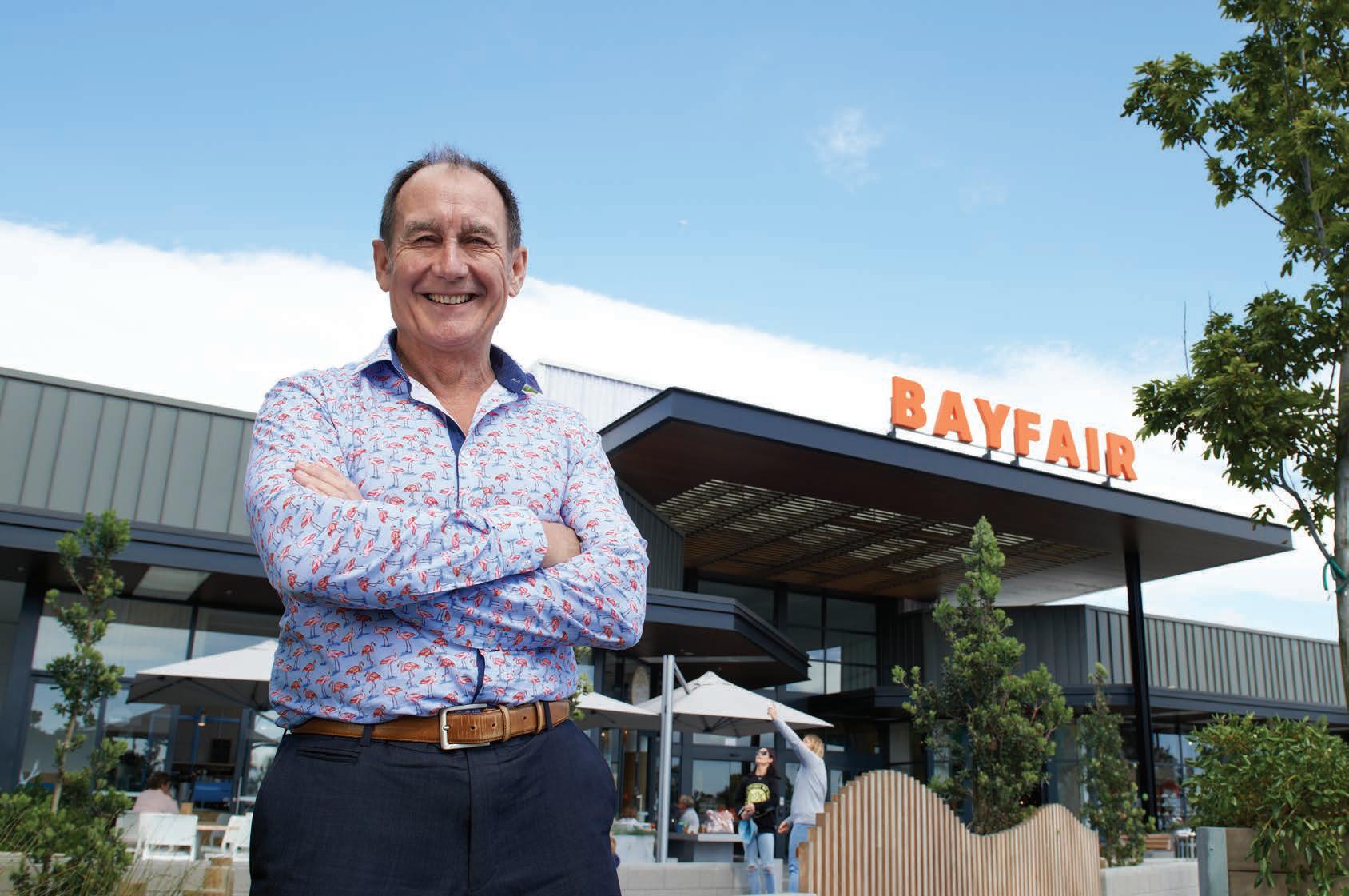
The Bayfair Redevelopment saw 11,000m² added to the Mount Maunganui shopping centre, including a supermarket, a bigger retail precinct, alfresco dining, a new cinema complex and parking.
The 3-year project, begun in 2017, and was undertaken while the existing shopping centre remained fully operational.
Centre Manager Steve Ellingford says they chose Foster Construction for the job because of their ‘can do attitude’ and customerfocused culture, which was a good fit with their values.
“Fosters were great” says Steve. “Their practical expertise was invaluable during the design process, helping us to manage construction costs.
“Once underway, there was a lot of pressure.
Timeframes for each stage of the project were hellishly tight, while public safety and ensuring our retailers could continue trading were critical factors in the overall success of this project.”
Much of the resources and subcontracting work was delivered by Bay of Plenty businesses, ensuring local engagement in creating the new community hub. For Fosters, this is key in any project.
“The Foster team worked with each delivery timeframe in mind, pulling out all the stops to get the job done” continues Steve.
“This project was successful because Fosters can manage the complexities of a project this size and deliver a high-quality product. I would certainly work with them again.”
